




LVT provides a rapidly deployable enterprise-grade safety and security ecosystem that can eliminate blind spots and protect any physical environment.

THE LVT DIFFERENCE
RAPIDLY DEPLOYABLE Our solarpowered, cellular-connected solution can be up and running in a matter of minutes.
SECURE WITH LVT Your data never hits a public network. All customer data is protected with AES-256 encryption at rest and TLS 1.2 during transit.
AUTOMATED DETERRENCE Keep bad actors on their toes with industry-leading AI-generated audio deterrents that refer to an individual’s clothes and attributes without human intervention.
Reduction in shoplifiting
Reduction in trespassing
Reduction in burglaries and break-ins
Reduction in disorderly conduct
SEE LVT IN ACTION
We’re introducing all new capabilities with Agentic AI. Schedule a free demo today.



Save time and money while improving safety for your organization with dearly detection. Our visual and audible deterrent proactively addresses this by combining a powerful built-in speaker with a visual deterrent. When paired with an Axis network camera and AXIS Object Analytics, it detects potential intruders and immediately triggers a clear, audible warning – either pre-recorded or live – along with flashing strobe lights, helping to prevent break-ins before they happen.
Powerful all-in-one strobe and speaker:
> Multiple LED colors and custom audio
> Built-in speaker with two-way audio
> AXIS Audio Manager support
> PoE out to power additional devices
> IP66-, NEMA-4X- and IK09-rated


Lauren Fritsky

Adam Gilvin


Billiot, CFI, Regional Asset Protection Manager, Hibbett Sports.
If you are a frequent reader and follower of LP Magazine, you may have noticed an emphasis and renewed focus on mentorship. There’s a reason for that. We hear from leadership across the country, from all retail formats, that there is a shortage of LP recruits who have a particular set of skills. Not to sound like a line from a Liam Neeson movie, but there are some intangibles that successful LP professionals exhibit. Curiosity, drive, and stick-to-it-iveness, to name a few, are skills that are extremely hard to teach. These soft skills lead to problem-solving abilities, logical risk-taking, and flexibility. Seedlings of these skills were likely nurtured by a mentor along the way for anyone who has advanced in their LP career.
Once upon a time, we worked in teams, together, in the same location, even if it was just briefly during a training period. And when you did something stupid, there was someone there to call you out on it before you really ran amok. Or if you were feeling uncertain, a coworker with more experience could tell you, “You’re on the right track.” We shared excitement over big cases, lifted each other up during the hard times, and celebrated the small wins together. We learned from other business partners as well. I can vividly remember sitting in a cash office, learning exactly how cash made its way in and out of the building from a patient manager. She put up with my questions and encouraged me to ask more. These sorts of informal mentorships are what helped me move along my career path.

How do we help people feel comfortable enough to reach out when one of those scary, career-changing scenarios crops up? My advice: truly see people and lean in. Zoom has its limits, but so do our travel budgets. We must do more with what has been given to us. Make the best of your time together and truly see that person on the screen. Ask questions, show compassion, and genuinely care about what’s going on. It’s not perfect, and nothing may ever be as good as sharing stories over a cup of coffee. It’s a matter of setting priorities and making time. Sharing LP Magazine with your new hires and peers is another way to mentor others informally. Make sure they are subscribed and ask them about what they’ve read. It could generate some fascinating conversation, and maybe you’ll learn a thing or two as well. After all, mentorships benefit both parties involved.
Not to sound like a line from a Liam Neeson movie, but there are some intangibles that successful LP professionals exhibit.
But, I’m worried. When our teams continue to work remotely and increasingly alone, how do we foster these mindsets?
In this issue, we have several articles featuring leaders in the industry. Mentors, trendsetters, paradigmbusters, and trailblazers are all within these pages. They have generously offered their advice for developing teams and creating effective mentor-mentee relationships. You’ll also see their insights into what’s to come for LP and the changes they feel are essential in the way we do business. We continue to feature a diverse range of voices from various retail sectors, and I’m excited that more people are interested in writing for LPM. If you have a burning desire to write about your experiences in LP or what you see coming down the pike, reach out to us at Editor@LossPreventionMedia.com. We hope you enjoy this issue and pass it along when you’re done. l
President Caroline Kochman Caroline.Kochman@losspreventionfoundation.org
Vice President, Editor-in-Chief Stefanie Hoover, CFI StefanieH@LossPreventionMedia.com
Editorial Director Jacque Brittain, LPC JacB@LossPreventionMedia.com
Managing Editor Courtney Wolfe CourtneyW@LossPreventionMedia.com
Assistant Editor Allie Falk AllieF@LossPreventionMedia.com
Retail Technology Editor Tom Meehan, CFI TomM@LossPreventionMedia.com
Contributing Writers Lauren Fritsky David Thompson, CFI
Design & Production SPARK Publications info@SPARKpublications.com
Creative Director Larry Preslar
Advertising Strategist Ben Skidmore 972-587-9064 office 214-597-8168 mobile Ben@PartnersPR.com
Subscription Services New or Change of Address LPMsubscription.com or circulation@LossPreventionMedia.com
Postmaster
Send change of address forms to Loss Prevention Magazine 33 Walt Whitman Road,


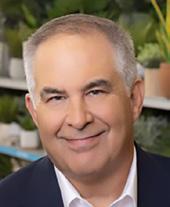
















LPM's Editorial Board is composed of some of the loss prevention and asset protection industry's top executives from a wide range of retail sectors. These senior executives provide guidance to the LPM team on article topics and industry issues that are of current concern and interest to LP professionals. To learn more about the Editorial Board, contact Stefanie Hoover, CFI, at StefanieH@LossPreventionMedia.com.







Rhett Asher SVP, Community Relations and Partnerships

James Stark Segment Manager, Retail

Stuart Rosenthal VP, Global Sales

Craig Greenberg Chief Commercial Officer

Dave Sandoval President

Alix Arguelles Director of Product

Tom Meehan, CFI CEO




Scott Thomas National Director for Signature Brands

Cita Doyle, LPQ, LPC VP, Sales and Marketing





Mike Jennings VP Sales, US Retail

Seth Hughes, LPC VP Retail Strategy and Innovation


Rex Gillette VP, Retail Sales

Jordan I. Rivchun Senior Director of Business Development



Matt Kelley, MBA Head of Retail, Go To Market


Kevin O'Brien EVP of Business Development

Robb Northrup Director, Marketing Communications


Tony Sheppard, MSM, CFI, LPC VP, Retail Risk Solutions


Nick Rykhoff President



LPM's Solution Partner Board is composed of the magazine's strongest solution provider supporters. These executives provide their counsel on how the magazine can better advance and serve the loss prevention and asset protection industry. To learn more contact Ben Skidmore at Ben@PartnersPR.com.

Chris Reene Head of Commercial

Chief Customer Officer

Sharon Costanza Senior Enterprise Account Executive

Ned McCauley Business Consultant, Retail Technologies

Scott Pethuyne, LPC Sr. Analytics Solution Consultant
Join these great companies as an LPM corporate sponsor. Email Editor@LossPreventionMedia.com for more information.





























Editor’s Note: The following is the testimony of Scott McBride delivered before the United States Senate Judiciary Committee on July 15, 2025. McBride is the chief global asset protection officer and CSO at American Eagle Outfitters, and a nineteen-year member and chair emeritus of the National Retail Federation’s LP Council. As one can imagine, it takes some grit to sit calmly before a committee at this level, and McBride did not disappoint with his stellar representation of the LP industry. To give LP Magazine readers a taste of what it’s like to testify before a judiciary committee, we present his testimony here, along with the subsequent questions that arose from the committee members, edited for clarity only. The questions from Senators Grassley and Padilla provide insight into what the industry needs to focus on as it continues to back the CORCA legislation.
Scott McBride: Chairman Grassley, Ranking Member Durbin, and esteemed members of the Committee, thank you for the opportunity to address you on a critical issue: organized retail crime (ORC). Chairman Grassley, thank you for reintroducing the CORCA Act of 2025 and inviting me to testify today.

My name is Scott McBride, and I serve as the chief global asset protection officer for American Eagle Outfitters Inc., a multichannel, multi-brand specialty apparel retailer operating retail locations, and ORC is far more than simple shoplifting; it represents sophisticated criminal enterprises perpetrating massive thefts, escalating violence against our associates and customers, crossing jurisdictions to avoid prosecution, and deploying professional-style tactics to fuel their nefarious operations, including reverse logistics, illicit liquidation, financial crimes, and recruitment. They repeatedly victimize retail stores of all sizes and disrupt our supply chains. An overview of the elements that define organized retail crime is attached.
Imagine an organization that leverages master’s-level business school concepts to unite individuals toward a common goal, meticulously measures results, harnesses technology to its advantage, and defines clear roles and responsibilities. You might assume I’m describing a successful retail corporation. However, this same organization employs intimidation and violence, uses electronic countermeasures to evade detection,

manipulates financial instruments through gift card fraud, and executes nefarious reverse logistics tactics to sell or move stolen merchandise offshore. This is an accurate description of how an organized retail crime group operates.
While ORC is not new, its veracity, sophistication, frequency, and geographic reach have dramatically increased in the post-COVID-19 era. These groups exploit the internet and encrypted messaging apps to recruit thieves, coordinate the consolidation of stolen goods, liquidate them through illicit online tertiary or black-market sites, and even exfiltrate stolen products out of the country. Simultaneously, retailers have invested in new technologies that provide clearer insights into the scope of these thefts, pinpoint the last known locations of missing items, time-stamp video evidence of incidents, and enhance collaboration with law enforcement across all jurisdictions. Despite our efforts, the problem continues to grow.
Consider a recent case where Homeland Security Investigations (HSI), working alongside state and local law enforcement, successfully interdicted a consolidation and exfiltration scheme. Stolen apparel was being prepared for packing onto sea-land containers destined to cross the Texas border into Mexico. With the assistance of corporate field investigators, HSI recovered ~2,000 pairs of American Eagle jeans with a
retail value exceeding $100,000, along with nearly $2 million in other retailer merchandise. RFID research revealed that these stolen AEO items originated from thirty-five American Eagle stores across thirteen states. Evidence from this seizure has already led to the discovery of a second arm of the same criminal group in Utah and has generated additional investigative leads across multiple states. Without the national reach of HSI, we would not have achieved such success in developing this ongoing case; a case far beyond the reach or understanding of any one local or state law enforcement agency, given the magnitude of the crimes across a multitude of jurisdictions. This example clearly underscores the urgent need for national-level involvement to support local and state law enforcement, district attorneys, and state attorneys general. National visibility and link analysis are crucial to comprehending the entire scope of criminal involvement, enabling the appropriate agencies and offices to make the legal determinations commensurate with the full scale of the criminal activity and lead to the disruption and dismantling of these organized criminal groups.
I commend Senator Durbin for his leadership in championing the passage of
“These groups exploit the internet and encrypted messaging apps to recruit thieves, coordinate the consolidation of stolen goods, liquidate them through illicit online tertiary or black-market sites, and even exfiltrate stolen products out of the country.”

–Scott McBride
the INFORM Consumers Act. While success varies by retailer, progress is being made toward INFORM becoming an effective tool in the fight against online marketplaces serving as easy funnels for the liquidation of stolen products.
In some of the thefts, the most sophisticated suspects adopt a stealthier approach to avoid detection; many other groups have escalated to intimidation and overt violence. Our store staff face threats with knives, guns, or even dirty needles. Perpetrators use pepper spray, destroy displays, and physically assault associates through punching, kicking, or shoving. Tragically, my peers have witnessed serious trauma, and in some cases, the deaths of customers, associates, security personnel, and in-store loss prevention staff at the hands of organized crime members.
A further example is when twenty stolen vehicles, carrying forty or more individuals, suddenly converge on a suburban department store, armed with implements of destruction from tire irons to firearms, running through and over customers, and threatening staff to commit retail theft—this is no longer a simple “smash-and-grab.” It is a coordinated attack with premeditated malice and a clear determination to plunder and escape. The stolen items are not necessities; this group had a plan for consolidation, fencing, and moving the stolen product, operating under the direction of a larger entity with the means to mobilize and monetize their illicit gains.
In conclusion, the Combating Organized Retail Crime Act (CORCA) is an essential missing layer. It would establish the Organized Retail Crime and Cargo Theft Coordination Center, bringing together federal, state, and local law enforcement with private sector experts to share vital information and collaborate on strategies

to keep our stores and supply chains safe and secure. This bill would allow us to expand upon the progress made at the state level and effectively address cases that meet certain thresholds or cross state lines. As a professional dedicated to protecting customers and associates, I implore all members of Congress to work together to ensure that the Combating Organized Retail Crime Act urgently becomes the law of the land. This critical legislation will help us stop these senseless crimes in our communities. Thank you for providing me with this opportunity to share our story. I look forward to answering your questions.
distinct and complex criminal enterprise or group involved in the systematic theft of merchandise and frauds. These groups are orchestrating, directing, and coordinating the thefts and frauds impacting retail shrink, but it is a critical misrepresentation of the issue to compare a retailer’s shrink to the impact of ORC.
l Retail shrinkage is too broad to be directly correlated with only theft. As mentioned, shrink calculations do include theft, but also include a number of various areas of non-related theft inventory loss.
l Shrink calculation methods differ retailer to retailer based on accounting practices, merchandise mix, and the number of physical inventories taken.

(R-IA), Chairman Grassley: There’s a lot of confusion about the availability of data related to organized retail crime. Terms like shrink are often conflated with other types of loss, creating confusion. What is the difference between retail shrink and organized retail crime? McBride: Retail shrink is an overarching accounting term that represents all inventory loss primarily within retail stores and for many, distribution centers. Shrink, often represented as a percentage of sales, provides retailers a moment-intime inventory of losses that may include theft but also administrative errors, damages, vendor fraud, and depending on the retail segment, spoiled goods or waste. Organized retail crime, however, is not a specific element of shrink although some of the thefts involved in ORC are calculated within shrink. ORC is a
“The Coordination Center within the CORCA bill will provide the critical link to help retailers and law enforcement to provide information that can be properly analyzed to establish the criminal relationships between locations, suspects, vehicles, and other assets that are used to mobilize and monetize the stolen merchandise.”
–Scott McBride
l Not all ORC-related theft is reflected in shrink. For many retailers, cargo and supply chain thefts may be reflected in their profit and loss statement as a cost of goods. Thefts and frauds involving credit cards or gift cards may show in a financial loss line—neither being part of a retailer’s shrink percent.
l Sales volume and diverse inventory can result in low shrink loss. Shrink is the “sum of the whole” involving both inventory and sales. A retailer can have high losses in low-dollar items or high losses in high-dollar items and still have an overall low shrink percentage at the store or organization level. For decades, retailers have offset the impact of increased theft by focusing on controlling other elements of inventory loss, such as administrative errors, damaged goods, and vendor fraud. This strategy has allowed them to compensate for rising ORC losses. However, the capacity for retailers to continue mitigating ORC losses through these means is diminishing. If ORC remains unchecked at national and transnational levels, the consequences will include higher prices, limited product availability, and the potential emergence of retail deserts.
Grassley: What contributes to discrepancies in reporting data on organized retail crime?
McBride: From the retail perspective, each retailer has their own incident recording processes and data reporting capabilities. For most, even those with sophisticated systems and controls, it may still limit the overall view of the scope and complexity of organized retail crime. A retailer may define a theft as
ORC based on their own ability, reach, and determination. ORC is not a singular crime; to identify and determine whether a theft has occurred in part of a larger ORC network or group requires investigation beyond the initial act of theft.
Retailers have also been challenged with how law enforcement may respond and report data related to organized retail crime. Responding to a local incident, local law enforcement could report an incident as a burglary or if violence is involved, a robbery, thereby removing the initial theft from reporting statistics.
These crimes frequently cross jurisdictional boundaries, making it difficult for any one local or state law enforcement agency to grasp the full scope of the activity. The complex nature of these criminal networks, involving various roles like boosters, mules, fences, and money launderers, further complicates data aggregation and clear identification. Retailers have invested in new technologies that provide clearer insights, but without a national-level

coordination center that allows private sector and law enforcement at all levels to share information, the ability to connect these incidents across states remains a challenge.
The Coordination Center within the CORCA bill will provide the critical link to help retailers and law enforcement to provide information that can be properly analyzed to establish the criminal relationships between locations, suspects, vehicles, and other assets that are used to mobilize and monetize the stolen merchandise.
Grassley: How would the Organized Retail and Supply Chain Crime Coordination Center that my bill, the Combating Organized Retail Crime Act, establishes help solve these problems?
McBride: The Organized Retail and Supply Chain Coordination Center, established by the Combating Organized Retail Crime Act (CORCA), would serve as a critical layer of collaboration. By uniting federal, state, and local law enforcement with private sector experts, the Center would
facilitate the sharing of vital information and the coordination of strategies. This collaboration would provide national visibility and enable crucial link analysis, leading to a comprehensive understanding of criminal involvement. This collaboration and knowledge of the true extent of a criminal group’s activity will assist with deconfliction at the federal level, creating a more efficient and effective federal response to large-scale national and transnational investigations.
This Center would build on state-level progress, effectively addressing cases that meet specific thresholds or cross state lines. Consequently, appropriate agencies could make legal determinations commensurate with the full scope of criminal activity, thereby disrupting and dismantling organized criminal groups.
Grassley: The Organized Retail and Supply Chain Crime Coordination Center is charged with establishing relationships with state and local law enforcement, along with the retail and transportation industries, in an effort to share information



and coordinate responses. Why is it important to have law enforcement and private industry coordinate to share this information?
McBride: ORC groups operate as sophisticated criminal enterprises, crossing jurisdictional lines and exploiting vulnerabilities across the entire supply chain. Therefore, it is critically important for law enforcement and private industry to coordinate and share information. Private industry (e.g., retailers, transportation companies) collect and possess vital information and details regarding thefts that occur across their stores and organization, and unique insights into the scope of these thefts through advanced technologies like RFID and surveillance analytics.
Private industry can provide information and images that can pinpoint locations, suspects, and merchandise, often with timestamps to support law enforcement as evidence.
Currently, the ability to coordinate a response in many cases extends far beyond the reach or understanding of any one retailer, local police department, or state law enforcement agency. The Coordination Center would provide the missing nexus of supporting a single repository of information-sharing for all key stakeholders in this effort to curtail this national crisis.
Grassley: The Organized Retail and Supply Chain Crime Coordination Center, led by Homeland Security Investigations, brings together multiple players to solve this problem. At a federal level, Customs and Border Protection, Secret Service, Postal Inspection Service, ATF, DEA, FBI, and the Federal Motor Carrier Safety Administration will all staff the Organized Retail and Supply Chain Crime Coordination Center. What advantages do these agencies bring to the table?
McBride: Each of these agencies brings a crucial and distinct advantage to the table:

l Customs and Border Protection (CBP) is essential for addressing the exfiltration of stolen goods across land and sea borders.
l The Secret Service brings expertise in financial crimes, which are integral to ORC operations, especially through gift card fraud and money laundering.
l The Postal Inspection Service addresses the use of shipping for illicit liquidation of stolen products.
l ATF and DEA are critical given the documented polycriminal activities of these transnational organizations, which include human, drug, and weapon trafficking.
l The FBI provides national investigative capabilities for complex criminal networks, specific financial investigations, and major crimes related to other organized theft groups (OTGs), who often engage in ORC-related activity to support other criminal activity.
l The Federal Motor Carrier Safety Administration (FMCSA) is vital for addressing cargo theft and the use of stolen vehicles for transport.
Grassley: Why are their viewpoints crucial to this effort?
McBride: Multi-agency viewpoints are crucial because ORC is not a singular issue but a complex web of polycriminal activity, transcending simple retail theft. These criminal networks engage in various illicit activities, including human, drug, and weapon trafficking, money laundering, identity theft, financial gift card fraud, smuggling, and cybercrime. Each agency contributes a specialized lens to identify, track, and disrupt different facets of these sophisticated operations.
Additionally, the complexity, severity, and polycriminal nature of ORC groups does not sit in any singular agency’s mission. A coordinated effort incorporating these diverse viewpoints is essential to fully understand the scope, scale, and interconnectedness of
“Retailers large and small should play a critical and active role in a public-private partnership that creates a collaboration to solve the many layers of criminal activity included in organized retail crime.”
–Scott McBride
these criminal enterprises, which exploit differences in legal jurisdictions to evade detection and prosecution.
Grassley: Why should HSI lead this effort?
McBride: Homeland Security Investigations (HSI) is the ideal agency to lead this national effort. They possess a proven capability in investigating the transnational nexus of ORC, interdicting consolidation and exfiltration schemes that cross state and national borders, as recently demonstrated by the recovery of millions of dollars in stolen merchandise.
Through Operation Boiling Point, HSI has shown its ability to respond to organized theft groups that profit from ORC and engage in various illicit activities. HSI’s national and international reach and ability to collaborate with state and local law enforcement are crucial for developing cases that often extend “far beyond the reach or understanding of any one local or state law enforcement agency, given the magnitude of the crimes across a multitude of jurisdictions.”
The coordination center concept involving multi-agency coordination and private sector engagement already exists within the HSI organization in the National Intellectual Property Rights Coordination Center (IPR Center). This existing Center has a long history in working with various law enforcement agencies and private sector organizations to stem the global impact and illicit trade of counterfeits and IP. Using the IPR Center as a model, it shows HSI’s extensive experience in identifying and disrupting transnational criminal organizations, identifying their suitability to coordinate this initiative.
Padilla: What internal controls does American Eagle have in place to prevent inventory diversion into gray or illicit markets?
Should large retailers be subject to federal standards governing inventory accountability before participating in enforcement partnerships?

McBride: At AEO Inc., we prioritize safeguarding our people, products, and
properties. Our robust asset protection program encompasses approximately 900 US stores, our online web platforms, and our extensive supply chain. We leverage advanced retail technologies such as RFID, surveillance analytics, and data-driven applications. These technologies provide a picture of inventory movement, helping us pinpoint the last known locations of missing items, and are critical for identifying and investigating potential inventory diversion.
Inventory control measures are a fundamental and well-ingrained aspect of a successful retail operation. The level of sophistication and effectiveness of these internal controls is a prerequisite for success in highly competitive markets. Imposing additional federal requirements for inventory accountability for a retailer to participate in a crime prevention program, such as the one proposed in CORCA, is therefore unnecessary. While internal inventory controls are vital for individual businesses, a collaborative approach through a Center like the one proposed in
CORCA would transform individual efforts into a collective, national defense. The focus should be on facilitating information sharing and coordination to address a problem that extends far beyond the capabilities of any single entity or set of internal controls.
Padilla: Does American Eagle currently share customer or transaction data with law enforcement or federal agencies as part of any loss prevention initiative? If so, what privacy or transparency safeguards are in place?
McBride: We do not share customer or transaction data in a manner that compromises individual privacy or tracks individual consumer behavior. Any information shared is strictly limited to what is necessary for law enforcement investigations, adhering to all applicable privacy laws and regulations.
AEO, Inc. cooperates with law enforcement and federal agencies to investigate and prevent theft, robbery, violence, and fraud. We provide information necessary to aid investigations, take action
against criminals and criminal organizations, and intervene to prevent further crime. Our intelligence sharing specifically supports investigations into organized retail crime, focusing on the theft and illicit movement of merchandise. We are committed to identifying criminal networks, recovering stolen goods, and preventing future thefts being orchestrated by these larger crime groups.
Padilla: As a leader in loss prevention strategy, what role do you think large retailers should play in a potential federal enforcement center like the one proposed under CORCA?
McBride: Retailers large and small should play a critical and active role in a public-private partnership that creates a collaboration to solve the many layers of criminal activity included in organized retail crime. CORCA is designed to provide the ability for local, state, and federal agencies to be more efficient and effective in combating this problem. From my perspective, a retailer’s role should include:









l Providing Expertise and Data: Retailers possess a broad and deep understanding of ORC’s devastating impact and have invested in technologies that provide clear insights into the scope of these thefts, pinpointing the last known locations of missing items and timestamping video evidence. We can share this valuable data related to known loss events, robberies, and cargo thefts with the Coordination Center, allowing law enforcement greater visibility into the magnitude of the crimes.
l Identifying Trends and Modus Operandi: Our day-to-day exposure to ORC allows us to identify emerging trends, new tactics employed by criminal groups, and specific target items, which are invaluable for proactive enforcement strategies.
l Facilitating Collaboration: We can serve as a vital link between the private sector partners/vendors and law enforcement, fostering the strong partnerships necessary for effective collaboration.
l Supporting Investigations: Our corporate field investigators can represent their victim companies and assist in the identification of recovered merchandise and other analytical data that may be helpful in the recovery of additional stolen products, the identification of transient groups, and increase the safety of the retail store staff.
l Advocating for Best Practices: Retailers can contribute to the development of best practices for preventing and responding to ORC, leveraging our experience to inform national strategies.
Padilla: Would you support legislative efforts that require retailers to adopt privacy and data-handling protocols before entering into any formal information-sharing arrangement with DHS or DOJ?

McBride: Retailers are committed to protecting the privacy of our customers and associates. We would support policies and necessary procedures that require the private sector responsible party who participates in direct information-sharing on ORC with DHS or DOJ to receive adequate online training on relevant privacy and data-handling protocols consistent with departmental policies and existing federal and state privacy laws. Retailers and private industry individuals already engage with federal agencies, utilizing Memoranda of Understanding agreements and proper training and protocols in other areas of information sharing systems and channels.
Padilla: How does your company avoid unfairly targeting low-income consumers, informal resellers, or gig workers when identifying potential organized theft threats?
McBride: Our focus at AEO, Inc. is on identifying and disrupting organized criminal enterprises that perpetrate massive thefts and engage in sophisticated tactics. Our advanced retail technology, including RFID and surveillance analytics, helps us identify patterns of systematic theft and the movement of large volumes of merchandise, which are hallmarks of ORC. We prioritize investigations where there is clear evidence of organized criminal activity, such as the use of electronic countermeasures, manipulation of financial instruments, nefarious reverse logistics, or the coordination of large-scale thefts across multiple locations.
Our partnerships with law enforcement are specifically aimed at dismantling these criminal networks, which often employ intimidation and violence, posing a significant threat to our associates and customers. We differentiate between individual shoplifting incidents and the structured,
“I do not believe that formal coordination with DHS under CORCA poses a risk of corporate overreach. On the contrary, it provides a crucial and necessary framework for addressing a problem that is currently beyond the capabilities of any single entity.”
–Scott McBride
often transnational, operations of ORC groups, ensuring our resources and efforts are directed at the true threat.
Padilla: Do you believe that formal coordination with DHS under CORCA poses any risk of corporate overreach, particularly if enforcement relies on tips, trends, or data provided by private actors?
McBride: I do not believe that formal coordination with DHS under CORCA poses a risk of corporate overreach. On the contrary, it provides a crucial and necessary framework for addressing a problem that is currently beyond the capabilities of any single entity. The Combating Organized Retail Crime Act establishes a Coordination Center that brings together federal, state, and local law enforcement with private sector experts, creating a collaborative environment. The “tips, trends, or data provided by private actors” are not the sole basis for enforcement; rather, they serve as vital intelligence that, when combined with law enforcement’s investigative capabilities, enables a comprehensive understanding and response to ORC.
Our nation already supports and relies on this form of coordination and sharing “tips, trends, and data” from the private sector and even public sources. HSI’s National Intellectual Property Rights Coordination Center (IPR Center) can serve as a model. The FBI and DOJ Internet Crime Complaint Center (IC3) receive information from the public and private sectors to report and investigate various cyber-related frauds. The Cybersecurity and Infrastructure Security Agency (CISA) utilizes public-private information sharing to strengthen our nation’s critical infrastructure across various segments to prevent cyber and physical threats and acts.
The intent of CORCA is to facilitate the sharing of information and coordination of responses to dismantle organized criminal groups. This is about leveraging the unique insights and data that retailers possess to empower law enforcement to act more effectively against sophisticated criminal networks, which are exploiting jurisdictional gaps and operating with increasing violence. The alternative—leaving retailers to battle these highly organized and often violent groups in isolation—will be detrimental to our communities and the safety of our citizens. l





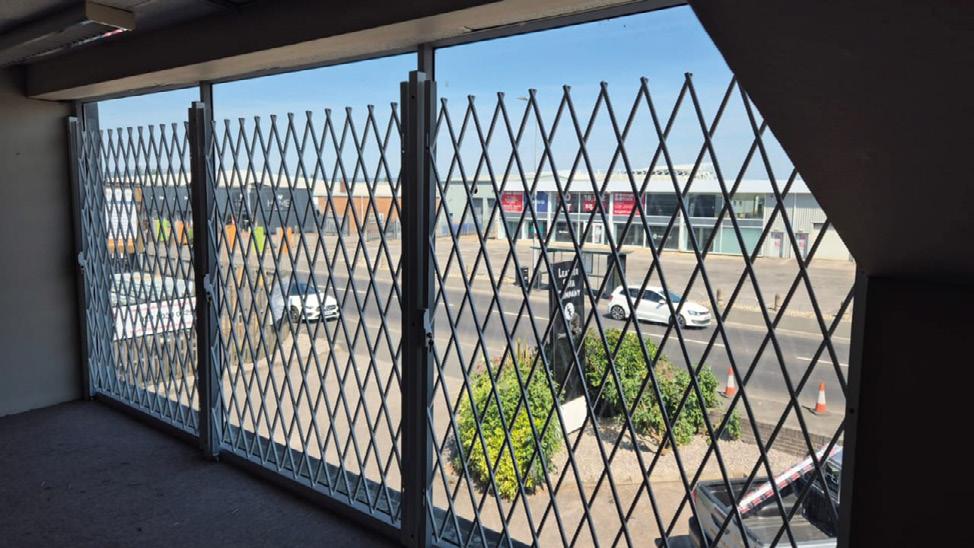


J.T. Manoushagian

Manoushagian is the chief of police for the Lake Worth Police Department, a metropolitan law enforcement agency in North Texas. With more than two decades of public safety experience, he is a strong advocate for collaborative policing and public-private partnerships. Chief Manoushagian is known for his strategic approach to crime prevention and his leadership in forging innovative alliances between law enforcement and the retail sector. You can email him at jmanoushagian@ lakeworthtx.org. Learn more about the Lake Worth Police Department at www.lakeworthtx.org/police.
In law enforcement, crime-prone neighborhoods generally receive the bulk of our attention. It’s a natural response— more officers, more patrols, more time. After all, when the threat is high, so is the urgency to respond. But when we consider the effectiveness of that response, we begin to ask a deeper question: Are we investing where we’re most likely to succeed, or simply where the pain is most acute?
Retail loss prevention faces a similar dilemma. When a particular store experiences high levels of theft, the natural tendency is to pour more resources into that location: additional personnel, advanced surveillance, hardened targets, and more. On the surface, this makes perfect sense. We assume more investment in problem locations will produce better outcomes. But what if our most targeted stores aren’t always our most strategic opportunities?

It’s hard to justify pulling resources from a visible problem to invest in a quieter one.
I propose a totally different approach: shift resources away from locations where the losses are greatest and instead allocate them where the potential for partnership with local law enforcement is strongest.
In military operations, when ground forces are overwhelmed, they call for close air support. But that air support is only dispatched when there’s adequate coordination on the ground—when those on the frontlines can communicate, guide, and act in tandem with those above. No pilot drops precision munitions into a black hole of silence. Why? Because without partnership, there’s no impact.
The same logic applies to loss prevention. A store suffering major losses in a jurisdiction where the local police department is disengaged, understaffed, or indifferent may continue to hemorrhage, regardless of how many cameras are added or how much inventory is tagged. Conversely, a store with moderate losses—but embedded in a community where the police department is collaborative, proactive, and data-driven—presents an opportunity not just for prevention, but for disruption. These agencies are more likely to investigate, apprehend, and prosecute. And when one of your stores becomes the
nexus for a multi-agency takedown of a regional theft ring, your investment has done more than protect a location—it has protected the brand.
In every jurisdiction, there are departments that lead. They seek intelligence-sharing, co-host offenderfocused retail roundtables, and integrate crime trends with your shrink data. These are the agencies that don’t just respond—they align. When retailers prioritize these partnerships, they don’t just reduce theft, they change the playing field.
Of course, I understand the reality: high-loss stores are often under pressure from corporate, shareholders, and the public. It’s hard to justify pulling resources from a visible problem to invest in a quieter one. But this is where loss prevention must resist the urge to operate solely in reaction mode. If your team is always chasing loss, you’re playing defense. But if you’re investing in proactive partnerships—even in places with modest losses—you’re playing offense.
Here’s what that might look like in practice:
■ Prioritize AP personnel assignments based on local law enforcement partnership potential.
■ Fund pilot programs in communities where police departments show initiative, even if theft levels aren’t yet alarming.
■ Share data proactively with departments that actually use it to pursue suspects and support prosecutions.
■ Develop key performance indicators that reflect relationship strength with law enforcement, not just inventory shrink.
Every community is different, and so is every police department. Some are reactive, others are strategic. The question isn’t just, “Where are we losing the most?” It’s also, “Where are we most likely to win?”
Retail theft is increasingly organized, mobile, and emboldened. But our response doesn’t have to be scattered. By aligning with law enforcement agencies that are ready to act—and investing in those relationships—retailers can shift from being victims of loss to leaders in prevention. l







Protect your products where it matters most, right at the shelf. SONR™ is a complete wireless ecosystem that detects product activity and instantly alerts store staff.
From hooks and shelf pushers to LM Tags and more, SONR™ solutions deter theft by letting offenders know items are being monitored, all while relaying activity to the SONR Echo Box up to 200 feet away.
Easy to install and scale to any category or store, SONR™ integrates seamlessly with your existing security systems to create a powerful tiered alert network. The result? Immediate deterrence, real-time awareness, and smarter protection for every product.
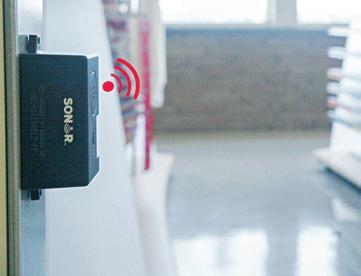

David Thompson, CFI
Thompson is the president and partner at Wicklander-Zulawski & Associates, providing investigative interview and interrogation training to a global audience. He has served as a subject-matter expert in developing curriculum and providing consultation to investigators, attorneys, and the academic community. He can be reached at dthompson@w-z.com.
© 2023 Wicklander-Zulawski & Associates, Inc
Haveyou ever walked out of an investigative interview thinking, “I know I missed something important”? Chances are that you didn’t lack skill, but you were mentally overloaded. Investigators are trained to ask the right questions, but how often are they trained to manage their own brain’s limitations? Investigative interviewing places extraordinary mental demands on the interviewer, and Cognitive Load Theory (CLT) helps explain why. CLT reminds us that the interviewer, like interviewees, only has so much mental bandwidth. The key is learning how to use it wisely.
The Interviewer’s Brain Under Pressure

In the interview itself, several strategic and logistical decisions can be made to assist the interviewer in minimizing the space occupied in their working memory.
Let’s say you’re driving to a new location, maybe a store in your market that you have never been to. Naturally, you’re jamming to your favorite music on the radio (probably T-Swift) and trying to beat the time on your GPS to arrive at your destination. As you get closer to your arrival and you’re waiting for directions on your final turn, do you turn down the radio? So that you can see better? What you’ve experienced is a management of your cognitive load, where distractions are reduced to focus on the task at hand. If we apply this same concept to the investigative interview, several factors contribute to the mental strain placed on the interviewer. We must listen while simultaneously assessing credibility and identifying gaps or contradictions in a story. The interviewer needs to be present in their ability to develop and maintain rapport, handle resistance, and keep the interviewee engaged. We need to consider contingency plans, manage safety considerations, and understand any vulnerabilities the interviewee may present.
This doesn’t even include any other pressures or outside noise. Worrying about what’s happening outside the interview room, including other workrelated tasks or being late to your next meeting, can also increase the load placed on our ability to focus.
Additionally, interviewers are also people living lives outside of the interview room—and these daily obstacles can occupy space in our brains, including an argument with a spouse or plans for the weekend.
The most important—and often overlooked—part of the investigative interview process is preparation. If interviewers can spend more time strategizing their conversation, anticipating objections or excuses, and developing an outline, they can potentially reduce the intrinsic load that may otherwise occupy some of their working memory.
Researcher John Sweller published an article in 1988, coining the term Cognitive Load Theory. He suggested that our working memory could only hold a certain amount of information at one time. Further research has broken CLT into different forms, including intrinsic, extraneous, and germane. Each of these sources of cognitive load has direct application in the investigative interview.
● Intrinsic Load: This relates to the specific difficulty of the task itself. A fact-gathering conversation with a witness or a simple theft case may not create a high intrinsic load. However, an interview that requires sorting through conflicting stories, examining data points, or focusing on a subject matter that an interviewer isn’t familiar with may prove more difficult.
● Extraneous Load: These are situational or environmental distractions that can drain mental resources unnecessarily. A poorly structured
interview environment, multitasking, or external pressures and distractions can all increase extraneous load on the interviewer.
● Germane Load: This refers to the effort invested in processing and applying information effectively throughout the interview. A complicated case involving conflicting evidence or data-driven investigations may increase the interviewer’s germane load, as they attempt to focus on the conversation. Additionally, an aggressive or resistant interviewee may force the interviewer to be more adaptive in their approach, which will take up more working memory space than a simple, straightforward conversation.
According to CLT, our working memory has a limited capacity to perform at a high level. When too many of these demands pile on, our performance suffers. This lack of ability to focus can result in missed cues, a lack of follow-up questions, and potentially, a gap in how much information we obtain. Interviewers who have reached a cap on their cognitive load may miss key inconsistencies or corroborating details in their conversations. This can also cause interviewers to be more susceptible to cognitive biases, relying on “gut instinct” as we aren’t as present in the investigative mindset.
Don’t worry, not all hope is lost. As long as we are aware of CLT and any potential impact on our abilities to interview, we can mitigate some of the liability that comes along with it. The most important—and often overlooked—part of the investigative interview process is preparation. If interviewers can spend more time strategizing their conversation, anticipating objections or excuses, and developing an outline, they can potentially reduce the intrinsic load that may otherwise occupy some of their working memory.
As part of the preparation process, interviewers should have both structure and flexibility in their approach. A structure will allow the interviewer to rely on their training and a working knowledge of the interview model to minimize the stress of wondering what to do next. However, the interviewer also needs flexibility in their approach so they aren’t beholden to a one-size-fits-all approach and can be more organic and adaptable in their conversation.
In the interview itself, several strategic and logistical decisions can be made to assist the interviewer in minimizing the space occupied in their working memory. Leveraging a note taker or secondary interviewer can assist in documenting details and examining information obtained as compared to the available evidence. Even more detailed (and accurate) would be the use of electronic recording to allow the interviewer to be fully present and then review the recording later when documenting the conversation or continuing the investigation. During the conversation, an interviewer can also be more intentional about
segmenting and summarizing an interviewee’s statement. In a fact-gathering or cognitive interview, periodically summarizing responses keeps both parties aligned and lightens working memory demands. This can also assist in notetaking and documentation after the interview.
Outside of the interview itself, investigators can work to mitigate extraneous load by being intentional in their setup of the conversation and their mindset. Ensuring the interview room is in a private and quiet location, while also focusing on contingency and safety plans beforehand, can put

As part of the preparation process, interviewers should have both structure and flexibility in their approach. A structure will allow the interviewer to rely on their training and a working knowledge of the interview model to minimize the stress of wondering what to do next.
the interviewer’s mind at ease. Attempting to be present and focused also requires an interviewer to leave personal matters outside of the conversation and clear their mind of distractions and unrelated tasks. Intentionally creating brief pauses or using reflective listening techniques may assist in their presence during the conversation.
The next time you walk into an interview, don’t just prepare your questions—prepare your mind and your environment. Recognize that your working memory has limits. Reduce distractions, structure your approach, and give yourself space to listen fully. Managing your own cognitive load isn’t just about making the interview easier; it’s about making the outcome more reliable. ●

Scan the QR code and answer questions about this article to earn CEUs towards your CFI designation or to learn more about the advantages of becoming a Certified Forensic Interviewer.
By Adam Gilvin
I’ve been in the industry for over twentyfive years, and I’ve done loss prevention just about every way you can. I’ve chased shoplifters. I’ve rolled back video. I’ve cleaned up freight messes and rewritten policy decks. I’ve sat at the table with leadership, with field teams, and with hourly team members trying to understand where things broke down—and how to fix them.
Throughout that time, I’ve learned this job isn’t about catching people; it’s about understanding people. It’s about understanding process. It’s about understanding what a number is really telling you.
For years, we treated shrink like a mystery. Like something that just happened if we weren’t lucky or didn’t have enough cameras. But shrink isn’t a surprise—it’s the result. It’s the answer to the test. Shrink is the grade.
Just like in school, you don’t argue with it. You don’t spin it, and you don’t get to explain it away. You earn it. And if you don’t like it, the only thing that changes it is doing the work.
We’ve heard the same lines for nearly a decade now. At every keynote, every conference, every article, we say:
• “We need to be proactive, not reactive.”
• “Shrink isn’t just theft. It’s a symptom.”
• “We need to partner with ops and HR.”
• “Engagement deters theft more than cameras do.”
These aren’t wrong; they’re true. But let’s be honest—how much have we actually changed?
How many companies still measure LP success by the number of apprehensions they make or the number of store visits they complete?
How many stores still view shrink as simply theft, or something to react to, rather than something they can influence every day?
How many AP leaders agree with these statements in theory, but haven’t rebuilt their systems, tools, training, or structure around them?
Saying the right thing and becoming the right thing are two different challenges. We’ve had the right ideas. But we haven’t always followed through with execution. And in retail, execution is everything.
Modern asset protection doesn’t chase, it prevents; it predicts; it aligns with how the business runs; and it integrates into the everyday—not as a check or control, but as a function that protects performance.
Today’s shrink is tied to:
• How you train your team
• How freight moves
• How clean your data is
• How disciplined your process is
• How you communicate risk before it becomes a problem
It’s operational, it’s cultural, and it’s measurable.
If you’re still waiting for a shoplifter or ORC group to set the tone for your LP team, you’re already years behind.
I’ve worked across a wide range of environments, and what I’ve seen hold true time and time again are three core pillars that anchor high-performing asset protection programs: talent, operational excellence, and customer engagement. This framework has guided how I lead, how I build teams, and how I evaluate what’s working.
1. Talent
• Do your people understand the connection between what they do and how the store performs?
• Do they know that shrink isn’t LP’s job—it’s theirs?
We train on that idea from day one—every team member, every leader. Shrink doesn’t sit in a silo; it’s threaded through how freight is received, how product moves, how decisions are made, and how standards are enforced.
If the store doesn’t take ownership, LP is just clean-up. That’s not a strategy.
2. Operational Excellence
Most shrink stems from sloppy execution: freight that isn’t counted, transfers that aren’t closed, or inventory adjustments that don’t make sense.
These aren’t security lapses—they’re discipline gaps.
That’s why our team builds simple, repeatable processes that make the right behaviors the default. We don’t wait for
How many stores still view shrink as simply theft, or something to react to, rather than something they can influence every day?
something to be stolen before we start caring. The goal is to get upstream—to catch what’s about to go wrong. Operational excellence is what holds everything together.
Engagement is more than saying hello at the door. It’s about presence, energy, and awareness.
It’s also about how the customer feels. When stores are well run, team members are active and available, and service feels intentional, not rushed or robotic. Customers feel safe and genuinely enjoy their experience. That feeling of being helped, seen, and taken care of builds trust. Over time, it builds loyalty.
And in that kind of environment, shrink tends to take care of itself. Not because there’s less opportunity, but because people behave differently in places that feel accountable, welcoming, and structured. Shrink declines organically when the store culture is strong.
When a store is dialed in, everything works better, including shrink.
We’re past the phase of talking about innovation—we’re in the phase where failing to act means falling behind. Asset protection can’t just nod toward technology; it needs to lead the integration of tech with execution. Not tools for tools’ sake, but platforms and practices that are built into the way work gets done.
Here’s what I believe the next evolution of AP must include—because these aren’t just ideas, they’re imperatives.
Stop treating risk like a static label. The shrink percentage from last year can no longer be your compass. Build live, rolling risk profiles that move with the business. Tie them to things that are changing now, like:
• Team member turnover
• Exception reporting patterns
• Freight throughput
• Missing scan alerts
• Markdown and adjustment activity
Start with your existing reporting tools—POS data, HRIS logs, cycle count integrity—and layer them with location-level crime overlays, SKU-level shrink rate, and traffic conversion variance. This becomes your real-time score, not to punish, but to prioritize.
And then tie it to action. If the score climbs, the store gets a visit, a targeted training, or a shrink sprint. Don’t just build the score, wire it to the playbook.
Fraud is shifting. The new battlefield is digital, and it’s not a fight AP can win alone.
That’s why partnerships matter. Strong solution providers can bring scale, but they can’t be bolt-ons. They have to be integrated into the fabric of how you work. Look for platforms that help identify:
• Returns abuse at the point of transaction
• Loyalty fraud through triangulation or points farming
• Refund manipulation and multiple order replays
• Account takeover via login telemetry and device mismatch
• Chargebacks that don’t align with CX or fulfillment logs
The goal isn’t just prevention. It’s seamless friction that protects margin without slowing the customer down. You want tools that get smarter with your data, not just ones that flag transactions after the fact.
If you’re working with a provider and still doing manual exports or sidesystem reviews, you’re behind. Demand integration. Build feedback loops. Make AP part of the fraud architecture, not just a user of the dashboard. (For what it’s worth, I’m always happy to talk through the solution providers that I have used, the ones I’ve tested, or the platforms I’ve researched and would like to integrate. There are real gaps in this space, but some are doing an excellent job understanding the assignment.)
for
Most internal loss never looks like theft until it’s too late. It’s masked inside normal workflows through:
• Repeated manual discounts on low-velocity SKUs
• Refunds paired with offsetting sales
• Transfers that “never arrived” but show as received
• Price changes that fall just under audit thresholds
Start flagging behavioral anomalies by combining transaction data, freight movements, and audit trails. You don’t need expensive software to start—just discipline and a schedule.
If it looks like a pattern, treat it like one. Quiet intervention beats reactive investigation every time.
You don’t need to confront every potential thief, but you do need to make them hesitate. And that starts with the environment. Modern deterrence is about:
• Lighting that eliminates blind zones
• Camera placement that enhances visibility
• Monitored “smart zones” powered by AI video analytics
• Passive audio reminders that reinforce awareness
• Planogram integrity that reduces hidden pockets
Some bleeding-edge retailers are piloting motion-triggered lighting with directional audio, self-auditing zones using computer vision, and even shelf sensors tied to anomaly-based triggers.
What matters is this: deterrence can run in the background. If your store’s design silently signals accountability, fewer people test the system.
Asset protection can’t stay in its own lane anymore. The companies leading in shrink performance aren’t just investing in tools; they’re giving AP a seat at the decision-making table. That means:
• Co-developing labor models with operations
• Influencing fulfillment processes with e-commerce
• Shaping policies around refunds, claims, and returns with legal
• Partnering on store layout and fixture design with visual and merchandising
• Helping finance understand how risk mitigation shows up in margin protection
The best solution providers won’t just pitch you a product—they’ll help you operationalize it across departments. But that only works if your internal teams are aligned and AP is treated like a core business function.
The companies leading in shrink performance aren’t just investing in tools; they’re giving AP a seat at the decision-making table.
Shrink isn’t a problem to solve—it’s a signal to interpret. And what you do with that signal should be a cross-functional effort, not a departmental task.
Personal Note—and a Challenge
This is where my philosophy has landed: Asset protection isn’t a reaction team anymore. It’s a performance function. It’s a cultural accelerant. It’s a leadership tool. And the results—good or bad—don’t just come from what we do. They come from what we tolerate, what we measure, and what we ignore. If you’re leading a team right now, I’d ask you this:
• What’s your company’s shrink grade today? Not what you hope it is, but what it actually is.
• Can you explain that result through process, behavior, or leadership?
• Have you changed anything in the last two years, or just said you need to?
• Do your people know how they impact shrink? Or are you still the only one thinking about it?
Because here’s the question I keep coming back to: Are you actually changing, or are you just nodding along?
The next decade in LP belongs to the teams who stop thinking like security and start thinking like operators, who build partnerships instead of checklists, and who prevent loss by preventing breakdowns. You can agree with everything I’ve written here. But unless you act—unless you operationalize it—it’s just another article.
Shrink already gave you your grade. The good news? You get a chance to raise it.
If you’re serious about leading in this space, don’t wait for another keynote, another pilot, or another system to push the work forward. Start with what you can control. Train your team. Clean up process. Get loud about what matters and silent about what doesn’t.
When you build the right culture around shrink, you don’t just protect the business— you make it better. ●

Adam Gilvin is the head of asset protection for Bass Pro Shops, bringing over twenty-five years of retail experience across store operations, investigations, supply chain, and enterprise strategy. His leadership philosophy centers on linking shrink to operational performance, team accountability, and customer engagement. Adam is focused on modernizing AP through data, technology, and practical execution, while building strong partnerships across the business.

In an industry where change is consistent and threats evolve daily, the Loss Prevention Foundation empowers professionals to lead, innovate, and secure the future of retail. Whether you are just starting or advancing in your career, the LPQ (LPQualified credential) and LPC (LPCertified credential) are the gold standards for credibility and competence.
Start your certification journey at www.LossPreventionFoundation.org
Industry-recognized certifications
Flexible online learning at your own pace
Trusted by major retailers
Career resources, community, and continued education
Follow us:







“With over twenty-five years of LP Experience, I was utterly amazed at just how much I was able to learn from this course. I found the content informative. It offered valuable insights into effective strategies for minimizing risks and enhancing security measures across various business environments.
Throughout the course, I gained a deeper understanding of critical LP techniques, which have influenced my approach to workplace safety and asset protection. The curriculum was both challenging and enlightening, equipping me with the knowledge and skills necessary to excel in this field. I strongly recommend the LPC course to anyone looking to advance their skills in LP.”
- Robert Figueroa, LPC, H&M
By Lauren Fritsky
There are over 150,000 convenience stores in the US, generating a collective $837 billion in sales—an amount similar to other categories perceived to be significantly larger, such as supermarkets and restaurants, which each generate about $1.1 trillion.
This rapid growth has outpaced the capabilities and infrastructure of many c-store loss prevention teams, which tend to be less robust than their retail counterparts. Even among larger chains, the fragmentation

in ownership and inconsistent technology adoption make it hard to scale loss prevention effectively.
“It’s a challenge we’re seeing more and more: stores growing faster than their ability to protect what they’ve built,” said Brian D. Gray, managing director, global head of fuels and convenience retail, at Accenture.
To understand the loss prevention opportunities as c-stores continue to grow, we spoke with a few experts who will participate in a panel at the National Association of Convenience Stores (NACS) Loss Prevention and
Safety Symposium on December 3 and 4. They shared the trends they are seeing in the space and how operators can prepare to capitalize on them as we head into 2026.
In Gray’s experience, c-store loss prevention is often driven by a mix of internal fraud, operational challenges, and external theft—just like it is for other retailers. What’s unique to c-stores is the vulnerability of specific categories.
“Lottery tickets, fuel, tobacco, and alcohol are all high-theft items because they’re easy to resell and can be hard to track,” he said. “Pair this with the fact that most convenience stores have very limited staff, which makes them more vulnerable.”
Employee theft—especially around the POS and fuel pumps—remains a significant issue. Operational errors, such as pricing mismatches and poor inventory tracking, also play a role. In the realm of external theft, shoplifting and organized retail crime are also on the rise, with smash-and-grabs and coordinated crew thefts that not only impact inventory but also force some c-stores to make tough decisions, similar to those made by their retail counterparts in recent years.
“In high-risk areas, the frequency and severity of these incidents have reached a point where store closures are becoming a potential response,” he said. “Unlike traditional retail, c-stores are especially vulnerable due to their 24/7 operations, minimal staffing, and easy access points.”
Often, c-stores face a scenario where it’s more local shoppers who are stealing products like alcohol, energy drinks, and cigarettes and selling them in the underground market, said Byron Coleman, CPP, managing director at Security Consulting Services.
“The majority of people are morally good,” he said. “There’s just a small, prolific group of individuals that taint the waters.”
There’s another crime that often impacts c-stores: human trafficking. Due to their always-open nature and locations in both urban and rural areas, they serve as frequent stops for people on the move— including victims of trafficking and their traffickers, said Cheryl Csiky, executive director of In Our Backyard, an organization dedicated to combating human trafficking that also partners with NACS.
“Human trafficking often intersects with other criminal activities such as drug trafficking, weapons offenses, and theft,”
she said. “Traffickers may coerce their victims into participating in these crimes, creating a cycle of debt, fear, and criminalization that makes it even more difficult for victims to seek help or escape. This overlap highlights how trafficking is not only a human rights issue but also a broader public safety concern.”

“Lottery
tickets, fuel, tobacco, and alcohol are all hightheft items because they’re easy to resell and can be hard to track. Pair this with the fact that most convenience stores have very limited staff, which makes them more vulnerable.”
Unlike many retail environments where purchases are purely transactional, c-store employees frequently engage in conversation at the counter, creating opportunities to spot red flags. C-stores also play a uniquely valuable role due to their accessibility, hours of operation, and frequent community presence. That’s why In Our Backyard launched the Convenience Stores Against Trafficking (CSAT) program in 2017. Within about a year, over 5,000 convenience stores had joined the program by posting the Human Trafficking Resource Center hotline in their restrooms. Now, over 50,000 convenience stores have posted Freedom Stickers containing the hotline nationwide.
Brian D. Gray
Convenience stores are ideal places to raise awareness because they serve as standard community hubs where people frequently stop, Csiky said. Additionally, the restrooms can serve as one of the only private spaces available to trafficking victims.
“Customers often view stores that participate in this program as committed to community safety, which actually strengthens customer loyalty,” Csiky said. “Victims or those being trafficked often see convenience stores as safe ‘pit stops’ during their journeys.”
The Total Loss framework, an overarching and fit-for-purpose definition and typology of the full range of losses that retailers experience, has been around for almost ten years. C-stores have generally been slower to adopt it, said Mark Stinde, MBA, LPC, vice president of asset protection at Midwest c-store chain Casey’s.
“If you think about convenience store retailers, there has been a more modest
investment in the asset protection function compared to other retail formats,” he said. “With limited resources, you tend to focus on the pressing issues right in front of you. It’s difficult to put focus in other areas when you don’t have resources to do that.”
However, he has seen more companies interested and engaged in adopting the philosophy.
When he first arrived at Casey’s, “We were really only focused on about 35 or 40 percent of the total loss in the organization,” he said. Many c-stores and retailers focus intently on malicious loss because it is most apparent.
Casey’s is a food-forward chain known for its pizza and other food offerings. Therefore, their total loss must include how they manage their perishable items—inventory on hand, product rotation, and code dates— as well as minimizing excessive waste.
“When you’re in a food-forward business, you have to look beyond the traditional pain points, or you’re going to be a step behind,” Stinde said. “With excess waste comes excessive cost, which erodes margin, and that, of course, erodes profitability for the organization. So, the importance of looking at areas outside of the traditional loss areas in the business is critical, and that’s why we look at the total loss in the business holistically.”
The industry is experiencing a shift toward more intelligent and proactive loss prevention, with AI playing a key role, particularly in video surveillance.
“The tech landscape for LP has changed substantially,” said Gray of Accenture. “We’ve moved from basic CCTV to AIenhanced video analytics that can detect a wide range of issues across the stores in real-time. Cloud-based platforms now enable centralized monitoring across multiple stores, and mobile dashboards provide managers with real-time visibility into incidents. Fuel pump monitoring has also become more sophisticated, helping prevent drive-offs and fraud. It’s a
much more connected and intelligent LP ecosystem than it was even a few years ago.”
AI-powered systems can flag suspicious behavior before it escalates. When paired with integrated platforms that link video, POS, and inventory data, they provide LP teams with a much clearer picture of what’s happening in real time. Gray has also seen significant momentum around proactive inventory management, particularly for high-risk categories such as tobacco and lottery.

“Victims or those being trafficked often see convenience stores as safe ‘pit stops’ during their journeys.”
Cheryl Csiky
“The goal now is to prevent loss before it happens, not just respond after the fact,” he said.
AI has also evolved in the realm of voice-to-text for virtual guarding, according to Coleman of Security Consulting Services. Some solutions can virtually place a guard in a store scenario, and mobile surveillance unit solutions can also trigger based on behavioral patterns generated by AI. Predictive analytics, particularly in the context of exceptionbased reporting for POS, has also been more heavily adopted by c-stores.
Coleman believes that “any of the technology associated with AI that allows people to focus on those valuedriven opportunities, as opposed to all the minutia that sometimes can get in the way” will be huge. The win is that the proliferation of AI technology is actually driving the price down, making it more accessible to smaller or mid-sized c-stores.
“As a c-store LP professional, I spent a lot of hours looking at unproductive video and unproductive leads,” he said. “AI can help speed up that time.”
Stinde points to computer vision tools as an emerging area that c-store LP professionals should consider and test where possible. These solutions can help with malicious loss, safety aspects, and operational challenges. AI-backed business intelligence tools are also transforming the c-store LP landscape by enabling more data-driven decision-making.
“We’ve developed some effective business insight and intelligence tools that help us manage total loss in the business,” Stinde said. “We’ve really reduced our use
of traditional spreadsheets and other tools to manage the business more efficiently. Our more dynamic business intelligence tools give us insight all the way down to the unit level, and that helps our operators better manage their businesses.”
These systems can also help boost employee productivity by enabling c-stores to tie store-level metrics to employee performance.
“Utilizing tools that are out there, and the advance of technology and AI specifically, I think will be a critical thing that we look at as AP practitioners for the coming years,” Stinde added.
Despite the promise technology holds to enhance the capabilities c-store LP teams have at their disposal, having a human touch is still critical. This means continuing to train employees from both a systems aspect and from a behavioral perspective.
“With so much changing across the markets and with technology, there’s definitely a need to upskill employees,” Gray said. “Team members need to know what to look for, how to leverage new LP tools, and how to respond to alerts being raised ultimately. LP teams are being asked to understand and interpret insights from data analytics, which is a big shift from traditional security roles.”
However, he has also noted an increase in investment in behavioral training.
“Scenario-based learning—like role-playing theft situations—is helping staff build confidence and capability,” he said. “Compliance training is also key, making sure everyone understands the legal boundaries across a variety of scenarios.”
Similar to the evolution of retail employee training, offering various options for team members to
engage with educational material can significantly contribute to adoption. At Casey’s, Stinde’s team uses some written materials, but also utilizes animation, video, and gamification to help educate team members. Microlearning also seems to be very effective.
“We’re not overloading the content, so the user gets the information they need, but it’s not onerous in terms of the time commitment,” he explained.
Coleman cautions against c-stores heavily relying on technological advancements to the detriment of simple people skills when it comes to what front-end employees should prioritize in their roles. In the name of increased consumer demand for speed and convenience, the POS experience has become more transactional. Consequently, some of the human touch associated with traditional customer service has been set aside.
“Most people know what they want when they come in, because they’ve done Google searches and informational searches,” he said. “So, you end up with a much more transactional, impersonal sales process, and to overcome that, you have to train how to interact with customers positively. Being able to teach people how to interact and de-escalate is a key factor, but positively impacting a customer can prevent theft in the first place,” he said.
Other types of c-store crime require a slightly different approach.

“As a c-store LP professional, I spent a lot of hours looking at unproductive video and unproductive leads. AI can help speed up that time.”
In partnership with the c-store industry, In Our Backyard has developed easy-to-implement training for store staff on how to recognize and report suspected trafficking. The presence of the hotline sticker inside restrooms provides a private and safe way for anyone—whether a child or an adult—to reach out for support in a public setting.
“We focus on safety—no one should intervene,” she said. “It can increase harm to the victim and those intervening. It’s best to wait until the situation is clear and make the call. It could be a tip that saves lives.”
Byron Coleman, CPP
Csiky shared that a short video training is available if you reach out to www.InOurBackyard.org or info@inourbackyard.org.
The organization can also coordinate a recorded Zoom meeting or webinar with management, if preferred, as an update for employees. In addition, they offer an HT101 Training Series, a threepart program designed explicitly for frontline employees, providing practical tools and knowledge on identifying trafficking, responding appropriately, and connecting victims to support. Posting Freedom Stickers in public restrooms, displaying awareness signage, and keeping this issue visible in stores are small actions that can lead to life-saving outcomes, she said.
The compassionate, cooperative spirit of In Our Backyard is something all c-stores can keep in mind as they look to enhance their strategies for addressing a range of LP and safety issues in 2026 and beyond.
“We got into the business because we’re human behaviorists, but now you must have a data analyst’s mindset, and then you have to have collaborative problem-solving,” Coleman said. “The
bottom line is that it’s taking everybody to help try to solve this problem.”
The NACS Loss Prevention and Safety Symposium will take place from December 3 to 4, 2025, at the Hyatt Regency DFW International Airport in Dallas, Texas. The event is open to all retailers and suppliers seeking knowledge, connections, and solutions critical to making stores safer; NACS membership is not required for this event. Register at www.convenience.org/events/ NACS-Loss-Prevention-and-SafetySymposium. ●

Lauren Fritsky is a seasoned journalist and content marketer whose work has appeared on CNN, AOL, USA TODAY, Huffington Post, Travel+Leisure, Entrepreneur, Adweek, and many other websites. She’s spent the last eleven years writing about IT, adtech, martech, retail, and e-commerce for global companies. Lauren earned a bachelor’s degree in English from La Salle University in Philadelphia. Contact her at Lauren.fritsky@gmail.com.
“When you’re in a food-forward business, you have to look beyond the traditional pain points, or you’re going to be a step behind. With excess waste comes excessive cost, which erodes margin, and that, of course, erodes profitability for the organization. So, the importance of looking at areas outside of the traditional loss areas in the business is critical, and that’s why we look at the total loss in the business holistically.”
Mark Stinde, MBA, LPC

The LP Magazine Founders’ Awards offer a means to celebrate industry accomplishments on an ongoing basis, recognizing the loss prevention professionals, teams, solution providers, law enforcement partners, and others who demonstrate a stellar contribution to the profession.
The ability to influence change is a product of drive, creativity, and determination, but it also requires a unique ability to create a shared vision that others will understand, respect, support, and pursue. Each of the following recipients reflects that standard of excellence, representing the quality and spirit of leadership that makes a difference in our lives, people, and programs. Please join us in celebrating the accomplishments of our latest honorees.

EXCELLENCE IN LEADERSHIP

Mark Stinde, MBA, LPC
Vice President of Asset Protection at Casey’s
EXCELLENCE IN LEADERSHIP

Senior Vice President of Asset Protection at Victoria’s Secret & Co.
“To be a true leader in the industry, you must understand that your success depends on the people,” says Stinde. “Whether it’s your direct reports, business partners, field partners, or every team member in the stores and DCs, their willingness to support the mission and vision of the programs you have in place is vitally important. It also involves collaborating and learning from other industry thought leaders, including solution providers. This supports the knowledge necessary for long-term success.”
Mark started his retail career selling shoes while attending school. He was often asked to assist with shoplifter apprehensions by the LP team and was eventually asked to join the department. He immediately knew it was what he wanted to do. Mark took his first leadership role as an LP manager. As he climbed the ladder, he held leadership positions with a number of prominent retailers before his current position as vice president of asset protection with Casey’s. His diverse background also includes Asset Protection Leadership Council Member with RILA, Editorial Board Member with LP Magazine, and his current role as Chairman of the Board with The Loss Prevention Foundation. “My growth in AP was supported by lots of mentors over the years,” he says. “I’ve watched how good leaders operated and tried to emulate how they’ve led.”
Mark feels his greatest accomplishment in LP involves the number of leaders who worked under his leadership who are now leading their own programs. “I would like to think that I had a small part in inspiring and motivating those leaders to excellence and making the commitment to do more in their careers. This industry has given so much to me—and I am very grateful. When I am done in the space, I would like to be remembered for how I inspired others and the impact I had on them.”
“A true leader combines deep functional expertise with genuine care for their team, demonstrated through consistent action,” says Talamo. “They inspire excellence, foster growth, and contribute meaningfully to their community.”
John began his career in retail as an internal/external theft investigator at Plymouth Shops before moving to Lord & Taylor, eventually leading a large team at the company’s flagship store in New York City. This paved the way for positions with increasing responsibility, culminating as director of security at Lord & Taylor. As his career progressed, he also held top leadership positions at Ann Taylor and L Brands before taking on his current role as senior vice president of asset protection for Victoria’s Secret & Co., where he oversees all aspects of asset protection, threat management, protective operations, and global travel safety, and is a co-leader of the Enterprise Crisis Management Team. John also supports the loss prevention community as the current chair of the NRF Loss Prevention Advisory Council and has served on the Columbus Police Foundation Board.
John feels his greatest professional achievement has been mentoring and developing asset protection professionals, many of whom now hold senior roles at retailers across the industry. “Supporting team members in reaching their career goals is a core value I have always been passionate about,” he says. “This is the best way to elevate the asset protection profession and meet the challenges of today’s rapidly changing theft and threat landscape. As a mentor, I’ve always felt that offering honest feedback is the best way to support career growth. AP professionals must evolve to anticipate the new interconnected risks and act proactively because our organizations count on us to protect our people, products, and property.”
“To accomplish your goals, never stop learning. Focus on mastering your core role and delivering results. Build strong partnerships, embrace innovation, be bold, and learn from any setbacks you may face.” ●
LP Magazine is recognizing the unsung heroes of the loss prevention and asset protection industry. In this ongoing column, we highlight those who are going above and beyond to help their community and world around them to be a better place. Whether it be an individual or a team, donating time, money, or bringing joy to others—we want to say, “thank you” and let our readers get to know them better. To nominate an individual or an entire LP team, fill out the form at losspreventionmagazine.com/something-good.


Doug committed his talents to serving our nation as part of the US military. As a combat veteran with eight years of service in the U.S. Army (2000-2008), he served in the infantry and military police, where he held many different positions.
Selflessness, empathy, and a genuine desire to help others embody the work of regional asset protection manager, Doug Billiot, CFI, with Hibbett Sports. Doug began his journey with Hibbett Sports in 2009 in his hometown of Graham, Texas, where he thrived as a head coach in the stores, servicing customers, and helping to develop future leaders. He was quickly promoted to district team leader, managing several stores across Texas and Oklahoma before joining the asset protection team in early 2018, where he now supports the stores in achieving their maximum profitability. Through this service to his stores, he has earned awards at Hibbett Sports for Regional Asset Protection Manager of the Year in 2022 and Asset Protection Investigator of the Year in 2024. However, his commitment to service reaches far beyond his excellence in asset protection. Over the last few years, Doug has not only invested in Hibbett Sports but has answered the call for service by self-initiating fundraisers and volunteer work for causes that have touched his heart.
Before joining the Hibbett Sports team, Doug committed his talents to serving our nation as part of the US military. As a combat veteran with eight years of service in the US Army (2000-2008), he served in the infantry and military police, where he held many different positions. He deployed to Afghanistan in support of Operation Enduring Freedom as a member of the 2nd Battalion, 5th Infantry Regiment. He later deployed to Iraq in support of Operation Iraqi Freedom as a member of the 759th Military Police Battalion. Following his active military service, Doug has continued to support veteran mental health awareness and has actively volunteered in fundraising events. On Veterans Day, Doug set up a Hibbett Sports booth at the Boerne, Texas, Veterans Day Softball Bash, which provided game balls for the homerun derby and the event’s all-star game, and also featured a Salute to Service car show.
Based out of San Antonio, Texas, Doug has been passionately involved in fundraising efforts for some of
the most heartbreaking tragedies that have occurred across the region. In 2022, during the Uvalde school shooting, Doug supported the families affected. As an avid collector of sports cards and memorabilia, Doug organized a community fundraiser, auctioning off some of his personal collection to raise over $5,000 for the Robb School Memorial Fund.
Most recently, the South Texas region of the country was devastated by severe flooding that took the lives of many people, including children, while causing extreme destruction across the area. Not one to sit idly by during this time of great need, he jumped back in headfirst to support the families across the region that were so profoundly impacted by the disastrous conditions. Once again tapping into an area of personal strength, he decided to rekindle his passion for sports memorabilia to ignite fundraising efforts. Working in concert with the sporting goods retailer, Doug reached out to his marketing department and received donated footballs that were signed by football stars and raffled off to support the victims of this tragic event. Funds collected from the fundraising event will be donated to the Kerr County Flood Relief through the Community Foundation of the Texas Hill Country.
Doug’s dedication to service grows from his genuine compassion for people. In the asset protection department, he has been affectionately nicknamed “the Mayor” because people seem to know him wherever he goes. It doesn’t matter whether he’s visiting a big city stadium in Dallas or eating at a quaint little diner in a town like Marble Falls—someone will inevitably speak to him as though they’ve been friends for years. This is just one of the qualities that make Doug such a special part of the Hibbett team. He takes a genuine interest in the community and everyone around him. Whether through his service in the US military, his commitment to Hibbett Sports associates, or his ongoing support of the people in his community, Doug exemplifies a life dedicated to people and service. ●
By Kam Leung (Sam) Yeung, PhD

The Current Problem
Imagine a town that gathered to share urgent news, but each group in the town spoke a different language. The builders used feet, cubits, and chalk marks, while the merchants counted by bundles, weight, or tally marks. Information was present, yet nothing matched, so arguments replaced action. A traveler finally introduced a common tongue, allowing requests and records to align. Once everyone could understand one another, progress was possible. In the same way,
shared data standards make intelligence building possible.
The challenge with standardizing crime data starts with how crime is labeled at the source. Law enforcement uses formal systems such as the National IncidentBased Reporting System (NIBRS), the Uniform Crime Reports program (UCR), the National Crime Information Center tables (NCIC), and state penal or statutory codes. These are designed for legal clarity and statistical reporting. Retailers, by contrast, design categories for business operations
and loss prevention, sometimes only a few, and sometimes more than forty. Even within a single retail brand, inconsistent training can lead to different coding choices for the same behavior. Police agencies are not perfectly uniform either because state statutes or local practices can diverge. The result is fragmentation at multiple levels: within one organization across locations, among different retailers, within law enforcement across agencies, and across the two communities together. When those layers stack, aligning data
becomes difficult, trends remain hidden, and collaboration slows precisely when it should accelerate.
Unified classification is not an academic exercise. For law enforcement, the ability to line up retailer incident data with formal categories can expose organized retail crime patterns that cross city or state lines. Repeat offenders who adapt tactics from store to store can be identified sooner if the underlying data is comparable. Retailers gain a clearer view of regional trends, allowing them to measure the effect of interventions such as employee training, shelf layout changes, or new anti-fraud controls. Executives and policymakers can make better decisions when they see an integrated picture rather than disconnected anecdotes. And, very importantly, retailers and law enforcement will be better able to evaluate where intelligence sharing is and is not happening by comparing similarly coded datasets. A common framework converts scattered records into shared intelligence so that investigations scale, resource allocation becomes defensible, and prevention moves from guesswork to planning.
Artificial Intelligence (AI), and specifically Large Language Models (LLMs) such as those developed by OpenAI and others, can function as a translator that reads short incident texts and maps them to standardized categories. Here is a worked example to make this concrete.
Example incident description: “Two individuals attempted to return stolen electronics using falsified receipts at the point of sale. When challenged, they left with no merchandise.”
In this example, there are two crimes that are mentioned according to common law enforcement taxonomies, including Fraud Swindle and Larceny Shoplifting. Fraud Swindle includes cases where a person gains or attempts to gain money or property through deception or trickery. Larceny Shoplifting covers the unlawful taking of merchandise from a retail establishment without deception, typically by concealment, with the intent of permanently depriving the retailer of those goods. Reading the narrative, an LLM would assign the incident to Fraud Swindle. The defining element of the behavior is deception by using falsified receipts
Retail teams and officers already write summaries. The goal is to make those summaries a little more structured and to share them with a trusted organization that can run the analysis.
to obtain a refund, and, importantly, no merchandise was taken from the store. Because the core action is deception rather than taking, the fraud category is the better fit.
This example matters because it shows inner reasoning in action. The model does not use keyword matching—if it did, it might classify the incident as involving both fraud and larceny. Rather, the model evaluates action, object, and context. The action is an attempted refund using falsified receipts. The object is cash at the point of sale. The context includes challenges by staff and no merchandise leaving the store. That triad is exactly the kind of compact description that enables accurate classification.
To scale this beyond one incident, we add two simple building blocks. First, embeddings and a vector database. An embedding is a numeric representation of text that captures meaning. A vector database is a specialized store that holds those numeric representations so that the system can search for similar items by meaning rather than by exact words. With embeddings, “fake return,” “receipt scam,” and “fraudulent refund” are recognized by the computer as representing similar types of activities, even if different staff wrote them in different ways. This helps analysts and investigators find clusters of related activity across many stores and jurisdictions.
Second, we can leverage Retrieval Augmented Generation (RAG). In a RAG setup, the model is provided with reference material at the moment of classification. For crime coding, that means definitions and decision rules pulled from NIBRS guidance, UCR summaries, NCIC offense tables, relevant state statutes, and the retailer’s internal categories. By letting the model consult that material as it works, the output stays aligned with the standards used in the field rather than drifting toward generic text.
A few practical enhancements improve accuracy further. Short, labeled examples that show the model what correct classification looks like can be included as few-shot prompts. Using few-shot prompts essentially means you are teaching the
model by example. For example, you might provide the following few-shot prompt:
Prompt:
Classify the type of fraud:
Example 1: “Customer returned empty box” → Return Fraud
Example 2: “Shopper switched price tags” → Price Switching
Example 3: “Employee gave refund without receipt” → Refund Fraud
Now classify this: “Shopper used fake coupon”
If a case management system (CMS) stores loss value or a pre-selected internal category, those fields can be passed in with the narrative to guide the classification. A theft of ten dollars looks vastly different from an organized grab-and-run of five thousand dollars in tools, and the model should be allowed to see that context. None of these enhancements require the retailer or the police department to build heavy infrastructure. They need only short, clear text and a trusted service to process it.
The near-term path is intentionally light on new technology. Retail teams and officers already write summaries. The goal is to make those summaries a little more structured and to share them with a trusted organization that can run the analysis. Focus on a brief, two-sentence description that contains action, object, and context. For example, “Employee processed fake return for cash after voiding the transaction in the register system” or “Two subjects concealed high value tools and exited through the garden door while a third distracted staff.” Those descriptions, together with existing fields in the CMS such as internal category and loss value, are usually enough for a classification service to map the incident into a standardized framework.
Repeat offenders who adapt tactics from store to store can be identified sooner if the underlying data is comparable.
Because resources are strained, it is not practical to ask every retailer or police agency to build a vector database or wire up a RAG pipeline. Instead, organize around data quality and data sharing. A trusted intermediary, whether an industry association like the LPRC, a regional fusion center, or a vetted technology provider, can host the needed tools. Participation becomes as simple as exporting a daily feed or posting structured summaries through a secure endpoint. This keeps the lift low while enabling modern analysis.
The idea of a continuous feedback loop, where analysts correct model outputs and the system re-trains, is attractive but difficult when local infrastructure is limited. In the first phase, keep the human in the loop periodically. Review a sample of classifications each month, compare them to internal expectations, and share notes with the service provider. Treat that as a lightweight governance process rather than a technical retraining exercise. As confidence grows, the intermediary can incorporate corrections into its service and report measurable improvements back to participants.
The benefits are possible, and they are significant, but they are not guaranteed. In the best case, unified classification would validate parallel trends between retail and law enforcement. Analysts would link similar incidents across companies and jurisdictions. Investigators would be able to build cases that recognize organized groups rather than treating events as isolated shoplifting. Retailers would measure the impact of specific interventions with more confidence. Command staff and executives would justify resource allocation with data rather than anecdotes.
All of that depends on an initial test. The first milestone is a proof of concept that uses existing reports with short, structured text. If the classification service consistently maps those incidents into a common framework with acceptable accuracy, then deeper features, like similarity search over embeddings or RAG for precise definition lookups,
can be added in a second phase. If early results are mixed, the remedy is often simple. Make the summaries clearer. Ensure that action, object, and context are written explicitly. Establish a short list of examples that staff can reference. Accuracy improves dramatically when the input is consistent.
There are limits to acknowledge. Vague narratives reduce effectiveness because the model cannot infer what is not written. Some incidents truly straddle categories and will require human judgment. Trust must be built over time through transparent evaluation. Privacy, security, and legal constraints on data sharing must be respected with proper agreements and role-based access. None of those barriers are new. They are the same issues any cross-organization data effort faces, and they can be managed with simple, documented practices.
As accurate classification services mature, the community can take bolder steps. Industry associations, like the LPRC, can curate a shared mapping that links common retail categories to formal law enforcement definitions and keep that mapping open for review. State and local task forces can encourage voluntary participation by offering investigative support to retailers who contribute structured summaries. Over time, a lightweight common vocabulary could emerge, similar to the way payment fraud codes evolved across banks and card networks. That vocabulary would not replace NIBRS, UCR, NCIC, or state statutes. It would function as a bridge that lets both communities see the same picture.
Implementation should begin with existing practices rather than new infrastructure. Staff should be instructed to draft two-sentence summaries that clearly state action, object, and context. A small sample of recent incidents can then be exported and provided to a trusted intermediary capable of classifying them against formal definitions. Human evaluators should
review the results to establish accuracy. If the proof of concept is dependable, expansion can proceed incrementally. Similarly, search over embeddings may be introduced to link related incidents across locations, and definitions can be consulted during classification through RAG. Accuracy should be measured and reported through a straightforward governance cadence. By emphasizing clear text, structured sharing, and phased adoption, retailers and law enforcement can progress from fragmented coding to unified intelligence, just as townsfolk once overcame linguistic divides by adopting a shared language.
Just as the townsfolk in the opening story discovered, progress comes not from shouting louder in different tongues but from discovering a shared way to speak. Crime data today is abundant, but scattered across dialects of statutes, policies, and retail codes that rarely align. With the help of modern AI, those fragments can be translated into a common framework where patterns emerge, connections are made, and collaboration becomes practical. A shared language of classification is not an abstract ideal; it is the foundation for investigators, retailers, and law enforcement to move in step against the realities of organized crime. When apples finally meet oranges on the same scale, the picture that emerges is clearer, stronger, and more powerful than either side could achieve alone. ●

Kam Leung (Sam) Yeung, PhD, is a research scientist at the Loss Prevention Research Council. He received his BS from Cornell University and a PhD in Cognitive Psychology from Iowa State University, where his research focused on consumer psychology and decisionmaking. With extensive experience in experimental design, statistical modeling, and data science, Sam applies Python, SQL, and large language models to address critical challenges in retail crime and safety. At the LPRC, he builds secure, large-scale data pipelines, analyzes millions of public records, and develops real-time dashboards that provide situational intelligence to retailers. He leads both the Retail Fraud Working Group and the Data Analytics Working Group, advancing projects on automated NIBRS-based crime classification, randomized controlled trials of prevention technologies, and simulation modeling of active shooter events in retail environments. His mission is to translate rigorous research into practical, data-driven strategies that reduce loss, improve safety, and strengthen retail operations. He can be reached at sam@lpresearch.org.


As the retail industry continues to evolve, so too does the role of LP. Once viewed solely as an in-store function, LP now plays a strategic role across both stores and distribution centers. From the moment a product is manufactured to its arrival on the shelf, risk can occur at any stage. That’s why LP leaders are now partnering more closely than ever with operations, IT, and supply chain teams to prevent loss proactively.
LPM: How is LP being integrated into supply chain operations today?
Hans Witt: LP is no longer an isolated or after-the-fact process. It’s now an integrated, proactive function of supply chain operations. Companies are increasingly using advanced technologies like AI, IoT sensors, blockchain, robotics, and machine learning to monitor products in real time and flag unusual patterns or activity. These tools make it possible to detect potential loss incidents before they escalate.
But this shift isn’t just about technology. More organizations are incorporating an LP culture across employee groups and extending that awareness to suppliers and third-party logistics providers. They’re also expanding the LP function to address broader risk areas such as return fraud, transaction monitoring, and cybersecurity threats that can compromise shipment data. In today’s environment, loss prevention must span both physical and digital threats—across every point of the supply chain.
LPM: How can RFID and real-time visibility help reduce loss during transit?
Witt: RFID and real-time visibility tools are revolutionizing how companies prevent loss during product movement. RFID allows for non-line-of-sight tracking, meaning products can be traced through distribution centers, trucks, and receiving areas without manual scanning. When enhanced with GPS and IoT sensors, RFID tags can monitor environmental conditions, detect tampering, and transmit alerts if a shipment is off-route or delayed.
These tools give LP and supply chain teams powerful insights that help deter theft, prevent operational errors, and create real-time transparency and accountability at every stage.
LPM: What is the purpose of supply chain and loss prevention partnering?
Witt: Collaboration between supply chain and loss prevention is key to minimizing shrink and improving overall efficiency. When these teams share data, they can paint a more complete picture of where vulnerabilities exist. For instance, LP data on theft incidents can help the supply chain team identify areas where inventory controls need to be tightened. Likewise, supply chain data can alert LP to weak points during transit or storage.
LPM: What are some actions companies can take to improve traceability and accountability from warehouse through shelf?
Witt: Improving traceability begins with implementing a robust warehouse management system (WMS) to track inventory movements digitally. Maintaining consistent digital records from suppliers to transportation to in-store receiving ensures a clear chain of custody. Companies should also establish clear standard operating procedures (SOPs) for product handling, labeling, and verification at each point of contact.
System integration is crucial. ERP, WMS, and TMS platforms must work together to create end-to-end visibility. Regular audits and compliance checks further strengthen accountability. Importantly, suppliers and vendors must be held to high traceability standards, with expectations clearly documented in contracts. Open communication and training across departments help reinforce these efforts and create a culture of shared responsibility. ●

By Allie Falk
What happens when doing what you feel is the “right thing” crosses a line—or breaks company policy? In high-pressure fields such as LP, one mistake could result in extreme consequences: the loss of hundreds or even millions of dollars, losing your job, or, in the worst case, injury or death.
Sometimes, making small decisions has a big impact, and there isn’t always a handbook on how to navigate these moments, leaving professionals stuck in a gray area.
This is where mentorship should come into play, but too often—it doesn’t.
That kind of gray area is exactly what tripped up a young, inexperienced loss prevention associate early in his career.
Vic Jacinto, CPP, LPC, now a respected industry leader, once made a wellintentioned call that, at the time, felt right. But it violated company policy.
While Jacinto ultimately recovered, reflecting on that moment as a turning point in his growth as a leader, he shared that he still wonders: “What if a mentor had been there? What if I had someone to call, someone with experience who could offer guidance in that highpressure moment? The outcome might have looked very different.”
The importance of mentorship shows up in a multitude of ways. Whether it’s feeling supported through one-on-one learning, gaining insight from others’ mistakes to prevent costly errors, or steadily climbing the professional growth ladder, a strong mentor can benefit anyone, regardless of experience, age, or background.
1. Mentorship Fills the Gaps Manuals Can’t
The most critical lesson s in loss prevention don’t come from a handbook; they come from real conversations.
“There are some technical aspects of learning how to do the job, which I think can come through mentorship,” said Vic Jacinto, CPP, LPC, safety and security manager at IKEA. “But I think the real wins are about the things that aren’t taught, like leading or managing people.”
Mentors help us navigate gray areas and reflect, especially after setbacks. “That experience taught me that mentorship isn’t just about helping people succeed—it’s about helping them recover when things go wrong,” said Jacinto. “Now, when I mentor others, I make space for the tough conversations. I talk about my own mistakes, because that’s where real learning happens.”
Brian Friedman, CFE, CFI, LPC, divisional vice president of AP at REI, agreed that the most impactful mentors aren’t always in your direct lane: “Mentorship isn’t about someone teaching you technical skills—it’s about having an adviser, almost like a personal board of trustees. The best mentors challenge assumptions and help you
slow down, pressure-test your approach, and move forward with confidence.”
But the lessons don’t stop with communication and emotional intelligence. Mentorship is also key to growing strategic business leaders.
Mark Stinde, MBA, LPC, vice president of asset protection at Casey’s, learned this firsthand from his first mentor, Mark Thomas, who embedded that mindset early.
“Mark told me, ‘Don’t just show up thinking your job is to catch shoplifters. Walk in and ask how sales were yesterday and find out what the business needs.’ That advice stuck with me throughout my entire career. That same mindset—thinking bigger than the task in front of you—is what separates tactical execution from true leadership.”
Khristopher Hamlin, vice president of AP at RILA, echoed that distinction: “Training manuals and e-learnings can teach you how to stop a shoplifter, but they won’t teach you how to lead, how to develop people, or how to drive business results. If you want to move beyond being an hourly detective and grow into leadership—manager, director, VP—you need mentors to guide you on that journey.”
“Those who’ve had strong mentors tend to have a more balanced skill set— they learn to think beyond just shrink reduction and instead address total retail loss, including ROI, and company-wide buy-in,” said Paul Jones, LPC, senior vice president at Gatekeeper Systems.
Learning from mistakes is inevitable, but the right mentor can help you avoid
the most painful ones, especially in high-stakes areas like apprehensions, investigations, or legal decisions. Earlycareer professionals don’t always realize how valuable that guidance is. They may make judgment calls alone—often hoping they’re doing the right thing. But mentorship helps you pressure-test your thinking before those decisions become missteps.
Stinde shared that early in his career, defensiveness was a personal hurdle. Mentorship helped him shift into a calmer, more strategic leader. “I used to get defensive with feedback because I thought I was doing the right thing. Looking back, that caused mistakes. Now, when mentoring others, I stress the value of listening calmly and thoughtfully.”
That same guidance has helped him avoid major errors in high-stakes moments, too. “I’ve made big decisions where I leaned on trusted mentors. Often, their advice was simple: loop in HR or legal first, keep leadership informed, or just sleep on it. That pause made all the difference.”
Mentorship also creates a safe space for honesty—and sometimes, that means hearing what you don’t want to. “A good mentor won’t sugarcoat it. I’ve had wild ideas that sounded great—until someone pointed out the legal or safety risks. Having someone to sanity-check your thinking is invaluable,” said Hamlin.
Jones highlighted how mentors openly sharing their past mistakes can be invaluable for mentees in loss prevention. “Effective mentors don’t just teach you the right way—they share the landmines they stepped on,” he said. “That kind of transparency helps you sidestep pitfalls in investigations, apprehensions, and
“Mentorship isn’t about someone teaching you technical skills—it’s about having an advisor, almost like a personal board of trustees.”
Brian Friedman, CFE, CFI, LPC

general loss prevention work, saving both time and trouble.”
Mentorship isn’t a one-time transaction; it evolves with you at every stage of your career. Whether you’re starting out in LP or already a seasoned pro, the right mentor fits the season you’re in and the direction you’re headed. It’s about listening, supporting, challenging perspectives, and knowing when it’s time to grow into the next phase of the relationship.
“I believe 90 percent of a mentor’s job is just to listen—really hear what the mentee is struggling with,” said Hamlin. “Then the other 10 percent is giving concise, actionable feedback. Your leadership journey is like progressing through video game levels—you eventually ‘graduate’ from some mentors because you’ve mastered that stage. You learn to recognize when it’s time to seek new guidance that fits your evolving challenges.”
Jacinto emphasized that mentors shouldn’t just hand over solutions, but guide mentees to find their own paths. “Sometimes people just need to see alternate paths—whether career-wise or problem-solving. A mentor isn’t handing over a fish; they’re giving a fishing pole.”
Recognizing when to evolve the mentor relationship is part of growth.
“Knowing when to move on is important because relationships have cycles,” Jacinto said. “Whether business, friendship, or romance, relationships sometimes end. It can be hard to say, ‘This has been awesome,

but it’s time to move on, without severing ties. We move around in circles for a bigger reason.”
Jones added an important perspective on the dynamic nature of mentorship: “Both mentor and mentee must be actively engaged in listening—not just hearing to respond, but to truly understand. The best mentorships come from that mutual respect and openness, where feedback flows both ways and the relationship grows over time.”
“I didn’t know who to call.” It’s a common sentiment among LP professionals navigating today’s remote or hybrid environments. The informal connections that once fueled mentorship—desk drop-ins, ridealongs, casual lunch chats—have largely disappeared. Without those organic touchpoints, newer team members are often left unsure of who to turn to or how to even begin the conversation.
As Stinde explained: “Our field teams are very autonomous— they’re by themselves, working from home before heading out to stores. There’s a real need for us to stay connected. That’s where one-on-one conversations, skip-level discussions, and even informal check-ins become essential. Sometimes I’ll just pick up the phone and call someone in the field—not for any business reason, just to check in. ‘How’s it going? How’s your new ops leader?’ That connection matters. And if you’re early in your career, you also need to be intentional;
“The most important lessons in loss prevention don’t come from a handbook; they come from real conversations.”
Vic Jacinto, CPP, LPC
reach out to the people you respect and ask for that coaching.”
Some mentors find that virtual settings help them listen more deeply and engage more effectively.
“I think for the people that I mentor today, I have become a much more effective mentor virtually than inperson. In-person, you’re focused on body language and trying to mentally put yourself in their shoes,” said Hamlin. “But virtually, I can just close my eyes and fully listen. I’m able to be more agile, meet more frequently, and give more organic feedback.”
Jones highlights practical ways to maintain meaningful mentorship remotely: “Regular informal checkins, like ‘coffee talks,’ help leaders stay connected with junior staff, providing space to discuss challenges and achievements. These low-effort conversations keep the mentorship alive, even from a distance, reinforcing that leadership and support don’t need to be face-to-face to be effective.”
In today’s hybrid and fast-paced environment, mentorship requires intentionality and adaptability. Successful leaders blend structure with flexibility, tailoring their approach to fit individual needs and circumstances.
At the core of effective mentorship is a rhythm of consistent, purposeful connection—whether formal or informal. One team, led by Stinde, has adopted a weekly cadence of structured meetings to address field concerns, alongside informal chats to maintain connection and trust.
“We have a structured cadence— our Monday meetings are built around what the field needs from us to be more effective. It’s not just top-down; the agenda is shaped by their challenges, and we respond. But I also believe the unstructured moments—those informal check-ins or side conversations—are just as critical. People often open up more in those moments, and that’s where trust gets built,” said Stinde.
Not all mentorship needs to follow a set schedule. Hamlin meets with mentors and mentees monthly or
bi-monthly, supplementing gaps with light “assignments” tied to prior conversations.
“In between sessions, I’ll usually give my mentees a small assignment—nothing formal, just a quick text or update on how things went. It shows they’re taking action and gives me insight into their growth,” he said.
Some of the most impactful moments happen during everyday interactions—over commutes, in messaging apps, or out in the field. Stinde often checks in with team members during travel or invites them to join market visits. “Even if I’m in-market for one person, I’ll invite others to ride along. We all learn from the collaboration.”
Jacinto emphasized that allowing mentees to set the pace can make the relationship more sustainable. “If it’s not scheduled, it’s not going to get done—but I also try to be flexible so they don’t feel locked in.”
Friedman summarized it simply: “The more you do it, the easier it gets. If you try to over-engineer it, it can feel overwhelming. But small,
consistent moments of guidance build real mentorship.”
Mentorship doesn’t just support individual development—it shapes how leaders show up for others. Stinde noted a marked difference in professionals who came up under powerful mentors. “There’s a noticeable difference in leaders who’ve been mentored by other reputable, strong leaders. You can see it in how they build partnerships, carry themselves, and think strategically,” he said.
Paul Jones echoed this, noting the growth in mentees with strong guidance. “You can tell who had great mentors. They show a more balanced skillset and handle both the technical and relational sides of LP well. It shows in their approach and results.”
To Friedman, strong mentorship often reveals itself in preparedness. “People with strong mentors tend to produce better work and face challenges with
more confidence. And when someone not only advises you but also advocates for you—that’s when you really see them shine.”
The difference mentorship makes isn’t always obvious—but over time, it shows up in confidence, consistency, and leadership that lifts others up.
While flexible formats and consistent touchpoints are key, mentorship ultimately hinges on the relationship itself. Effective mentorship often starts with finding the right person—not just someone with a title, but someone who’s walked a similar path.
Friedman reinforced the importance of finding the right mentor early on: “I used to think if something went wrong, it was all mine to carry. But mentorship showed me the value of managing upward and pulling in the right advisers early. That shift from ‘owning it all’ to ‘building a coalition’ changed the game.”
Hamlin encourages early-career professionals to seek out mentors who’ve

held their current role or one just ahead of it. “Even if it’s not formal, just connecting with someone a few steps ahead of you can be the best first move you make.”
Several companies are exploring matchmaking platforms that use experience, communication style, or shared values to create better mentormentee connections. Reaching out directly can feel overwhelming in fast-paced roles. Hamlin suggests a natural approach: starting with simple advice requests rather than formal mentorship asks.
“I didn’t go around asking people to ‘be my mentor’—that rarely works. Instead, I reached out to people doing what I wanted to do and just asked for advice. That simple exchange would grow into regular conversations, and before they knew it, I had adopted them as mentors. No formal title, just real guidance.”
Jacinto advises looking beyond direct managers for mentorship to ensure objective guidance free from performance pressures. “A lot of people think their boss has to be their mentor, but that dynamic can be tricky. Sometimes it’s better to have a mentor who isn’t in your reporting line.”
The value of mentorship is clear in career and personal growth. Hamlin noted, “I look at key leaders across major companies in the LP community today, and in most cases, I not only know them—I know who mentored them. Those with strong mentorships tend to rise through the ranks and succeed.”
Jacinto agrees: “I’ve seen growth—in awareness, communication, confidence— that’s very apparent. Strong mentorship
absolutely makes a difference, even if others can’t always pinpoint why.”
Building a strong mentorship culture starts with making it a natural and ongoing part of team life—not something formal or intimidating. Encouraging open recognition and support among peers creates an environment where mentorship can thrive. Fostering unstructured recognition within teams encourages those doing well, affirms their work, and gives others an incentive to do better. There’s no hierarchy here—everyone should feel comfortable reaching out, as Stinde puts it. This kind of culture lays the groundwork for meaningful mentorship to grow organically.
Leaders can keep mentorship simple and consistent by regularly checking in on their teams and asking about current struggles. It doesn’t require much time, but the effort shows care and keeps connections strong. As Stinde said, “It doesn’t cost anything and takes you a minute. Just checking in to see how folks are doing… when you take the time to reach out—especially if they’re in a new role or haven’t heard from you in a while—it shows you care.”
Teaching people how to mentor is equally important. Effective mentors listen before they advise, creating space for mentees to explore their own thinking before offering clear, actionable feedback. Jacinto captures this coaching mindset well, noting the value of trust and pushing each other to grow.
Reinforcing that mentorship is for every level helps normalize it across a career.
“Mentorship isn’t a nice-to-have—it’s how we avoid million-dollar mistakes.”
Khristopher Hamlin

Even seasoned professionals benefit from having trusted partners to discuss challenges and gain fresh perspectives. Stinde shares, “I’ve been in this business since 1988, and I still take partners. I still look for people I can trust—mentors, colleagues—to say, ‘Here’s what I’m dealing with, how would you go about it?’ That keeps you grounded.”
Mentorship in LP isn’t a luxury—it’s an operational imperative. It mitigates risk, it sharpens judgment, and it accelerates the kind of growth that builds confident, strategic leaders who can navigate high-stakes decisions with clarity and care. Across the board, professionals who’ve benefited from strong mentors consistently avoid more mistakes, elevate faster, and stay more engaged throughout their careers.
Even at the highest levels, mentorship remains a tool for navigating uncertainty. As Hamlin put it: “Mentorship isn’t just a nice-to-have—it’s how we avoid million-dollar mistakes.”
But mentorship doesn’t happen by chance. In today’s hybrid, fastpaced work environment, building a mentorship culture requires intentionality. It means normalizing outreach, encouraging team-wide participation—not just top-down—and creating flexible, high-impact ways to connect.
If you’re a senior leader, consider who you’re guiding and how. If you’re just starting out, don’t wait for formal permission to ask for insight. Wherever you sit: start a conversation. Share what you’ve learned. Ask what someone else is working through. Because mentorship isn’t a moment—it’s the scaffolding of every decision, every mistake avoided, and every future leader rising in the ranks. ●

Allie Falk focuses on social media, daily e-newsletters, interviewing LP experts for magazine articles, and crafting email blasts. Prior to LPM, she was a digital content marketing intern for Tyler Technologies—the leading CAD software provider in the US—where she was awarded ‘Spotlight Intern’. Allie received her bachelor’s degree in communications from the University of Detroit Mercy in 2022, where she was awarded Communications Student of 2022. She can be reached at AllieF@ LossPreventionMedia.com

Tom Meehan, CFI

Meehan is retail technology editor for LP Magazine as well as CEO of CONTROLTEK. Previously, Meehan was director of technology and investigations with Bloomingdale’s, where he was responsible for physical security, internal investigations, and systems and data analytics. He currently serves as the chair of the Loss Prevention Research Council’s (LPRC) Innovations Working Group. Meehan recently published his first book titled Evolution of Retail Asset Protection: Protecting Your Profit in a Digital Age. He can be reached at TomM@LossPreventionMedia.com.
Have you ever wondered if that social media post, photo, video, or even news clip you’re seeing is real? This isn’t just a hypothetical question. The rise of affordable, advanced AI has made deepfakes entirely possible. What you are seeing, even if it’s convincing, could be completely fake or altered.
This leads us to something called the liar’s dividend. From a definition standpoint, the liar’s dividend drives credibility through misinformation. What better way to create misinformation than generative AI? The liar’s dividend will be a new defense where someone caught on camera or on audio doing something questionable, dishonest, or inappropriate can say, “That wasn’t me. It was a deepfake. It was AI!” And suddenly everyone’s left wondering if what they saw was real or if it was AI.

Gone are the days of asking, “Is that photo Photoshopped?” Now it’s, “Is that AI?” Imagine you are conducting an investigation, and must go to trial for a crime, and the defendant’s confession is caught on audio or video. In the age of deepfakes, their lawyer could argue that the video could be fake and that it was edited. Even a tiny seed of doubt is sometimes all you need to cloud the truth. It’s the same in politics, in real estate, in news, or in public life.
A recent study about this phenomenon was detailed by Yale’s Institution for Social and Policy Studies. The study, titled “The Liar’s Dividend: Can Politicians Claim Misinformation to Evade Accountability?” highlights how misinformation spreads and how politicians often cry wolf by labeling news as fake. Strategic and false claims that stories are fake news or have defects help politicians by causing doubt, scandals, or misconduct.
People can claim, “Hey, that’s just AI-generated nonsense. It’s not me.” We’re in a day and age where, as an investigator or professional, you need to be highly diligent in everything you read or see.
In the context of conducting an investigation today, any digital evidence can be questioned. Modern AI can manipulate watermarks, encryption, and timestamps, making these safeguards less reliable.
He Felt a Certain Pride: Murder Defendant Tells Judge He Killed Woman, but His ‘Confession’ Was AI-Generated
In this news story from the website Law and Crime, a murder confession caught on video was later claimed to be a deepfake by the perpetrator. Although this story is extreme, and in reality, the suspect appeared to have mental disorders at play, sensational headlines such as this continue to drive the narrative.
Today, as these tools advance, the line between real and fake grows increasingly blurred. We might end up in a world where every piece of digital evidence is questioned. The future could hold more skepticism. It’s our responsibility to figure out what’s real and what’s not.
It’s important to explore tools for verifying authenticity, with many designed to detect deepfakes in video and audio. If you search for an AI detection tool, you may get one that works well, or you may get one that gives inaccurate information.
About two years ago, I made the prediction that AI would change the way we write, and it has, in fact, done that. As AI reshapes writing, detection grows more challenging. Universities worldwide have even faced lawsuits where students were wrongly accused of using AI due to flawed detection.
Platforms like YouTube now tag AI-generated videos, showing progress but also limitations. Bad actors also stay ahead of deepfake detection, highlighting ongoing risks. The best approach is not relying on one tool, but recognizing consistent patterns in generative AI.
A documentation strategy for gathering evidence is essential. How do you make sure it was collected responsibly and that the chain of custody was maintained? Train your team to ensure they understand where AI is headed and why the chain is so important.
At the end of the day, the liar’s dividend isn’t just about how reality could be faked. It’s about making everyone doubt the truth altogether. Recently, I’ve had the opportunity to speak about AI more than twenty times. And I often say we’re in a time when everything we see or hear could be questioned. The old adage of “seeing is believing” no longer applies. As we move forward, we’ll need to be even more vigilant about how we separate fact from fiction. ●
By Courtney Wolfe

Coupons—and the way consumers use them—have changed quite a bit in the past decade. While physical coupons still exist, consumers are more likely to utilize digital promotions that arrive via email than to spend their Sunday afternoons clipping coupons from the newspaper. And though digital coupons are more convenient for customers, they can also make it easier for bad actors to commit fraud.
“Coupon fraud has become more prominent as technology has evolved,” said Macy’s VP of Asset Protection Operations and Strategy Chase Seitz. “Specifically, the ability to replicate and digitally distribute fraudulent coupons before the codes can be broadly shut down.”
According to Capital One, 165.5 million American consumers (equivalent to 62 percent of adults) redeemed digital coupons in 2024. As Seitz pointed out, it is more difficult to control these fraudulent digital coupons, so the impact on retailers’ bottom lines can be immense.
“Counterfeit coupons are not our biggest issue, but when they surface, they are used in mass and the financial losses can add up quickly,” said Frank Benesz, LPC, director of AP investigations and data analytics at Bloomingdale’s.
Though they open up the risk of fraud, coupons are essential to many retail operations, and become an especially important offering for consumers as the cost of goods increases. The global coupon market was valued at $727.3 billion in 2024 and is projected to reach $16 trillion by 2030, according to Capital One. Of those surveyed, 86 percent of online shoppers said they are more likely to try a new business due to a coupon, and 39 percent are much more likely.
“Coupon fraud continues to be a significant issue for retailers, even if it doesn’t always get the same attention as organized theft; the financial impact is still very real,” added Parker Griebel, LPC, LPQ, CFI, secretary on the Board of Directors for the Wisconsin Organized Retail Crime Association (WIORCA). “Fraudsters today have easier access to tools that allow them to create professional-looking counterfeit coupons, and the internet makes it simple for them to spread quickly through social media or online groups. At the same time, retailers are facing staffing challenges, and with high turnover on the frontlines, employees may not always have the confidence or training to question a suspicious coupon. Balancing fraud prevention with the desire to keep the guest experience positive can also make it more difficult to intervene.”
In the past, coupon fraud was mostly limited to paper coupons that were photocopied or slightly altered. But today, Griebel explains, the problem has shifted to digital formats, including app exploitation, fake barcodes, and large-scale organized efforts where people use fraudulent discounts across multiple retailers—making the fraud more complex and able to spread much faster.
Griebel said one factor that makes mitigating coupon fraud so challenging now is the role of social media.
“There have been cases where groups on platforms like Facebook, Telegram, and even Discord are used to distribute fake coupons or share tactics for abusing promotions,” he explained. “In fact, a recent example reported in Business Insider showed how fraudulent coupons went viral after people shared videos demonstrating how to repeatedly scan the same digital discount and then invited others into online groups to do the same. These kinds of ‘loops’ allow counterfeit offers
to spread quickly and on a large scale—far beyond what we saw in the paper coupon era.”
Technology has also made it easier to create counterfeit paper coupons, with bad actors manipulating and constructing physical coupons that look legitimate, with working barcodes.
“Usually, we can see individuals who manipulate coupons and use them repetitively in our stores,” Benesz said. “The most concerning bad actors learn the algorithms and number sequences, and they create an ongoing manipulation process as they know we have the ability to shut down individual coupons.”
While not a huge issue according to the retailers we spoke with, employees are sometimes involved in coupon fraud.
“Most coupon fraud is external, but there are cases of internal collusion,” Griebel said. “Sometimes employees will override systems for friends or family, or they’ll use their own accounts to abuse digital discounts. That’s why internal controls and monitoring are so important—to make sure the opportunities for this type of activity are limited.”
Benesz shared that he sees more employees being manipulated by criminals than using fraudulent coupons to their own advantage. “Internally, from time to time, we will see colleagues hold on to coupons or store them in their phones to give added incentives to their friends, which erodes our margin. More so, it is the bad actor that convinces an unsuspecting employee to accept their manipulated coupons over and over again.”
But employees must be warned that coupon fraud isn’t as innocent as it might seem.
“Coupon fraud is really just one part of the broader organized retail crime ecosystem,” Griebel said. “Offenders rarely rely on one tactic alone—they often pair coupon abuse with return fraud, refund scams, theft, and resale activity, meaning what appears to be a single fraudulent coupon at the register can actually be part of a larger pattern of coordinated loss. Coupon fraud ranges from opportunistic misuse, like copying or overusing a coupon, to highly organized schemes fueled by online communities and even dark web marketplaces where counterfeit offers are distributed in bulk. These organized efforts can cost retailers millions and damage the integrity of legitimate promotional programs.”
high-dollar redemptions or repeated overrides. Data analytics have also become a critical tool in spotting fraud across stores or regions, and teams can partner with manufacturers, coupon clearinghouses, and law enforcement when larger schemes are uncovered.
“Years ago, most of this work was manual and time-consuming,” he added. “Today, retailers have the benefit of automation, machine learning, and real-time monitoring to detect issues faster and with greater accuracy.”
Malcolm Gaspard, senior vice president of loss prevention for a large department store chain, said his team uses exception-based reporting—with special technology integrations catered to their needs—to understand when defrauding is happening.
In addition to exception-based reporting, Seitz said that Macy’s also distributes training alerts and storewide communications both proactively and in response to emerging trends, so that associates can identify and report suspicious coupons.

Typically, loss prevention teams use a mix of system controls and investigative work to combat coupon fraud, Griebel explained. Point-of-sale systems are set up to automatically reject coupons that don’t match items or exceed certain limits, and exception reporting helps flag unusual patterns like
“Coupon fraud has

this one.”
Training on common signs of fraudulent coupons and company policies around
acceptance and overrides is typical for retailers, but consistency is key. “They’re encouraged to be polite but firm if they need to deny a coupon, and to document and report anything suspicious,” Griebel explained. “The biggest challenge is making sure that training is consistent, especially in a retail environment where turnover can be high. When in doubt, employees should always call over a manager to help determine the next best steps.”
And while issues like organized retail crime or violence may seem more pressing, coupon fraud should be given its due diligence as well. “The biggest piece of advice I’d give is not to underestimate coupon fraud,” Griebel said. “Coupon fraud may not be as flashy as largescale theft, but it adds up quickly. Rely on your data, watch for patterns, and make sure your employees feel confident in how to respond to suspicious situations. It’s also important
doing to try to make sure we’re not having this massive amount of fraud,” he said. “We do tend to have some instances that pop up, but we try to rectify them pretty quickly.”
Benesz also stressed the importance of expiration dates. “Coupons are created for many events by our organizations. Many of them do not have an expiration date that will prevent that coupon from being scanned or manually entered. Work with your business partners to understand current promotions and your risk with outdated but still active barcodes. Work to have your organization’s algorithms change from time to time. In many cases, the date codes change but the rest stays the same, making for easy targets by the bad actors.”


“The biggest piece of advice I’d give is not to underestimate coupon fraud. Coupon fraud may not be as flashy as large-scale theft, but it Rely on your data, watch for patterns, and make sure your employees feel confident in how to respond to suspicious situations.”
to work with partners—whether that’s other retailers, manufacturers, or associations like WIORCA—because the same fraudsters are often hitting multiple companies in the same area.”
Gaspard said that his organization has a comprehensive plan in place for preventing coupon fraud that includes everything from looking at the numbering on coupons, to how often they’re released, and their expiration dates. “There’s a lot that goes into what we’re
This collaboration is key, as IT doesn’t necessarily completely understand fraud, and loss prevention doesn’t always completely understand the technology that goes into creating coupons.
As Benesz pointed out, many of the business partners within your retail organization have the same goal—to drive sales and margin. He urges loss prevention professionals to collect and use data to influence change if coupon fraud becomes an issue, as this may not be their expertise or priority, and data-driven solutions are the best way to influence change.
Seitz said that coupon fraud should not be a major focus for asset protection, rather an issue they can and should lend their expertise to. “Our role can be to flag and respond, while educating business partners in digital, IT, and finance on vulnerability and margin impact, and to facilitate the necessary system fixes and blocks.”
Gaspard reiterated the importance of working closely with IT.
“I think it’s important to see that you’re working with whoever is in charge of coupons and loyalty at your organization when they’re putting things out, so you have a say on the risks they may have, and then you can try to get in front of those before they’re rolled out, so you can minimize the impact and exposure you may have,” he said. “If there’s a digital wallet involved where coupons go into the wallet, it’s going to be important for you to stay close to those because they’re normally external companies, and you need to put a two-factor security alert into the system so that not just anyone can hack into customers’ wallets. That’s where most of this fraud happens, and once they have that access, they can get into your wallet, and there’s nothing the company can do. And they have bots doing this sort of stuff now.”
“The best way for retailers to respond is by taking coupon fraud seriously, documenting incidents thoroughly, sharing intelligence with partners such as law enforcement and
associations like WIORCA, and using data to connect cases across stores and regions,” Griebel summarized. “Doing so not only protects profitability, but it also preserves the trust of honest guests who expect a fair and consistent shopping experience.”
As digital coupons continue to climb in popularity, how will criminals continue to improve their own processes to defraud retailers?
“That is the question we must ask ourselves and work diligently with our business partners on forward-thinking strategies,” Benesz said. “With AI changing the landscape for businesses, the bad actors out there are looking to AI on how to better help serve their motives as well.”
Seitz agreed that retailers will need to improve their techniques and technologies, adding that e-commerce sites and POS systems will need to migrate to machine learning models to identify abuse and quickly mitigate.
“As more shopping moves online, coupon fraud is going to shift heavily into digital promo codes, mobile wallet offers, and app-based discounts,” Griebel added. “We’ll continue to see more attempts to exploit system loopholes, like stacking promotions or creating fake accounts. At the same time, e-commerce does provide retailers with better traceability and data to track redemptions, so the opportunity for detection is stronger. The retailers that invest in AI-driven fraud detection and stronger coupon validation systems will be in the best position to stay ahead.”
Like all forms of retail theft, coupon fraud will likely increase as prices for everyday items continue to grow. Thankfully, the technology that can help combat coupon fraud is improving. If you haven’t already, partner with IT to gain a good understanding of your company’s coupon program. From there, you can apply your LP knowledge and identify potential vulnerabilities—before they become national news. l

Courtney Wolfe is LPM’s managing editor focusing on creating and curating editorial content for the magazine’s print publication and website. Prior to LPM, she was managing editor for SDM Magazine, a trade publication for security systems integrators. She received her bachelor’s degree in multimedia journalism from Columbia College Chicago. She can be reached at CourtneyW@LossPreventionMedia.com.
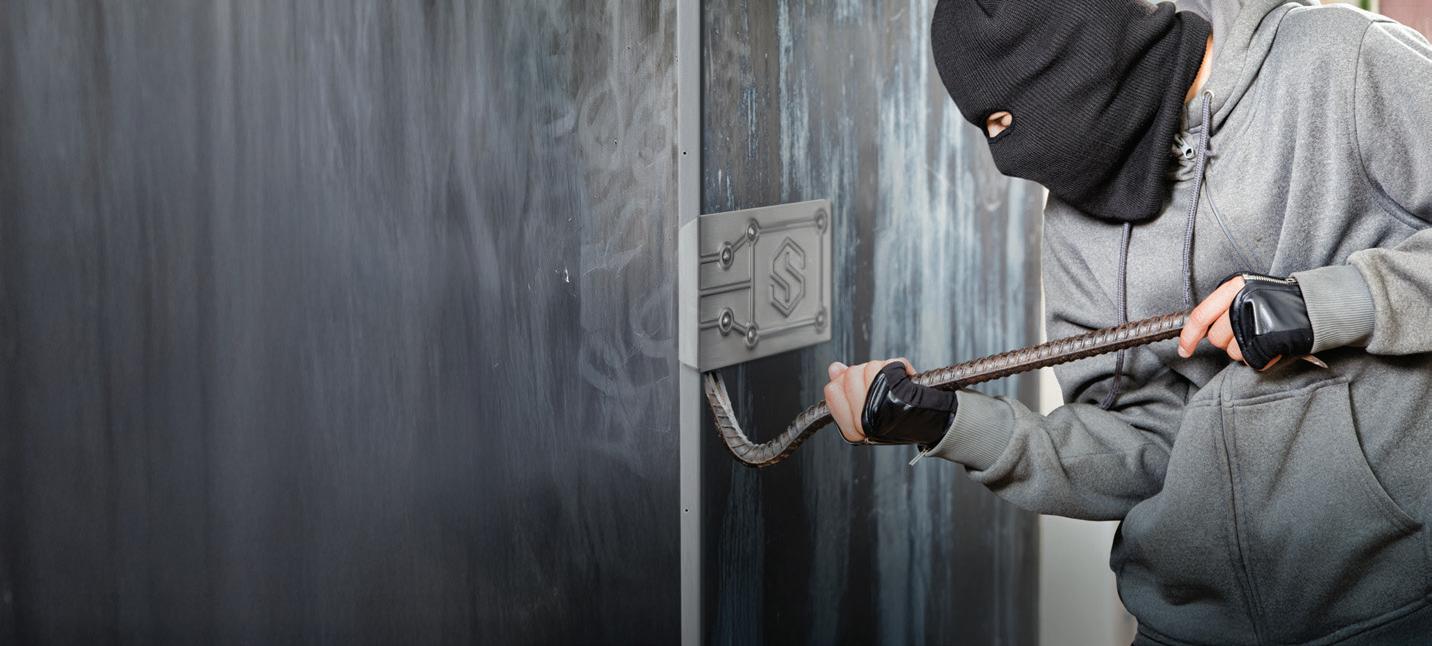


A multi-point deadbolt lock with maximum break-in protection.
■ Exterior lever trim; key or electric release (access control compatible)
■ ADA compliant
■ Exit alarms; captive key in alarm models, removable only when armed
■ Delayed egress locking module and controller
■ Door strengthening reinforcement kits and more
Five-point deadbolt projection against break-ins.
■ Instant deadbolt locking each time the door is closed
■ Vandal-resistant lever with resettable, breakaway slip-clutch
■ ADA and complete code compliance
■ Simple to install
■ Durable solution with over 1 million cycle tests
■ Designed for both in-swing and out-swing doors
Learn more about how major retailers are protecting retail’s most crucial doors for over 30 years.
www.securitech.com


Burke leads solutions management at Sensormatic Solutions, where he identifies and implements new ways of accelerating innovation, increasing speed, and delivering greater value to customers through a strategic solution roadmap. He is a proven leader with more than twenty-five years of experience in retail, including his tenures at Walmart and Sam’s Club, delivering innovation at scale. Most recently, Burke founded Divergent Technology Advisors, a retail technology advisory firm guiding major retailers, technology providers, and start-ups with technology strategy, go-to-market planning, international market expansion, and more. Burke holds degrees in mechanical engineering from the University of Kentucky and international business and philosophy from Georgetown College.
LPM: Myron, you’ve been in retail, on one side or the other, for a while now. What were your first impressions coming into Sensormatic and its impact on the industry?

Myron Burke: Sensormatic has always stood out in the LP space, thanks to its consultative approach and nearly sixty years of history. Coming into the company over a year ago, I was struck by the tremendous opportunities available to further leverage their global presence and deep industry expertise. Sensormatic operates in over ninety countries, serving diverse retail environments—from high-end fashion markets to unique shopping behaviors in regions like Latin America. Their ability to adapt to varying retail needs globally is an asset that hasn’t been fully tapped. Additionally, Sensormatic’s impact on the industry is significant, especially in the context of evolving retail trends. The company is well positioned to disrupt traditional approaches to asset protection and adapt to the digital transformation that has gained momentum post-COVID-19, such as e-commerce, online pickup, and digital returns. By embracing innovation and refreshing its portfolio with software-driven solutions, Sensormatic has the potential to redefine its role and drive an even greater impact in the retail space.
LPM: How are you thinking strategically about leading the evolution of loss prevention?
Burke: The evolution of loss prevention is being driven by the digitization of retail and the blending of asset protection functions into broader digital operations. Traditionally, loss prevention was managed by tactical teams, but it is now integrated into areas such as online order management, self-checkout, scan-and-go shopping, and fulfillment. This shift has forced asset protection teams to adapt rapidly to new risks, like theft associated with digital transactions and self-checkout systems, and blurred the lines between asset protection, inventory management, and risk mitigation.
Strategically, we are focusing on transforming loss prevention into a more holistic asset management approach. This involves using technology to improve
visibility and control across the supply chain, quantifying shrink at each node, and addressing anomalies with operational and technological solutions. For example, we’re leveraging metadata, digital transactions, and advanced tagging (such as RFID) to track inventory more effectively and pinpoint areas of loss—whether it’s theft at the point of sale, discrepancies in receiving, or shrink across the supply chain.
The goal is to redefine shrink from an unknown metric into a fully quantifiable one, enabling targeted interventions to minimize losses. By investing in tools and processes, we can help retailers manage inventory more precisely, improve accountability, and strengthen deterrents against theft. This approach also supports continuous improvement, tailoring solutions to address the unique challenges of underperforming stores versus high-performing ones. Ultimately, as retailers adopt these advanced technologies, they create stronger deterrents against bad actors and foster a more secure retail environment.
In addition, we’ve been implementing sensor fusion, where outputs from multiple sensors—sometimes three, four, five, or more—are integrated into a unified data stream. This allows us to achieve extremely high levels of accuracy, often 98 to 99 percent, in identifying key factors like the product involved, the time, location, and even the perpetrator. By combining these inputs into a single metadata stream and physical image, we create hard artifacts that are reliable and immutable. This integration of data and technology enables a far more effective approach to loss prevention.
At the same time, we are mindful of balancing innovation with privacy considerations. While tools such as computer vision and machine learning bring significant benefits, some applications can add unnecessary complexity. Our focus is on practical machine learning algorithms that tie physical evidence to actionable insights—for example, matching a red square to the words “red” and “square,” but scaling that principle globally. This approach creates reliable matches based on hard artifacts, ensuring
precision and accountability while helping retailers address shrink and loss with greater clarity and efficiency.
LPM: At the end of that strategy, what is the value to retailers?
Burke: The value lies in the ability to better mitigate and manage shrink, rather than completely solve the problem, because this issue is ongoing and evolves as new challenges and workarounds emerge. For every solution developed to address shrink, there will always be efforts to exploit weaknesses, creating a continuous cycle of adaptation. The ultimate goal is not to eliminate shrink entirely (which would be prohibitively expensive) but to quantify it accurately and control it more effectively.
By breaking down shrink into specific, measurable categories, such as errors or losses at distribution centers, transportation issues, store-level shrink, or intentional theft, retailers gain clarity on where losses are occurring and the scale of the problem. For example, instead of managing vague company-wide shrink figures, they can pinpoint specific $100,000 issues at a distribution center or store and then address those targeted areas.
Quantification enables actionable insights, whether it’s identifying human error, prosecuting theft, or improving operational processes. Retailers can then decide the level of tolerance they are willing to accept and balance the cost of tighter controls against operational efficiency. The overall value is empowering retailers with the tools, data, and visibility to make informed decisions that reduce shrink, improve profitability, and adapt to evolving risks over time.
LPM: What do you think is the big up-and-coming thing in loss prevention in the next five years?
Burke: Sensor fusion will be a major advancement in loss prevention, combining technologies like RFID tags, video metadata, acoustic magnetic sensors, and other inputs to create highly accurate and integrated systems that identify loss events in real time. This technology will allow retailers to process data at the edge, linking specific items, locations, and actions to individual shoppers with highdensity artifacts that minimize false positives and improve accountability. Sensor fusion will also help retailers address organized retail crime more effectively by creating actionable insights tied to specific events and individuals.
Beyond detection, the way retailers engage with customers around loss events will evolve. Some stores may opt for visible deterrence, like alarms or public notifications. In contrast, others may prefer more subtle approaches, such as private messages or personalized communications, to maintain a specific store experience. For example, digital tools could send reminders to customers about forgotten items at the bottom of their basket before they leave the store, reducing shrink without confrontation. These methods will increasingly integrate customer loyalty programs and digital profiles to enable tailored interactions.
Additionally, hardware capabilities will continue advancing, but the focus will shift toward how software and data are used responsibly. Retailers will need to balance precision and transparency while avoiding false accusations, ensuring that loss prevention
solutions protect both the business and the customer experience. Over the next five years, the amalgamation of technologies—sensor fusion, edge processing, and smarter customer engagement—will redefine loss prevention, making it more proactive and integrated into the retail ecosystem.
By breaking down shrink into specific, measurable categories, such as errors or losses at distribution centers, transportation issues, store-level shrink, or intentional theft, retailers gain clarity on where losses are occurring and the scale of the problem.
LPM: Finally, as you hear from customers, what is the most consistent challenge or insight that has really resonated with you, and how are you thinking about helping retailers through it?
Burke: The most consistent challenge is the internal conflict retailers face between driving inventory, asset protection, and traffic management controls while maintaining a seamless customer experience. Different departments within a retailer, such as operations, merchandising, marketing, and customer experience, often have competing priorities, making it difficult to harmonize solutions. For example, there’s tension between implementing visible deterrents, such as cameras over high-risk items, and ensuring customers don’t feel targeted or uncomfortable in the shopping environment. Balancing these competing needs is a significant challenge.
To address this, we’re focused on creating solutions that integrate into the store environment without disrupting the look, feel, or experience. Asset protection and traffic management tools don’t need to feel industrial or intrusive; they can be designed to fit seamlessly into the retail space while providing the necessary protection and insights. This involves listening to the diverse voices within retail organizations and ensuring that solutions satisfy not just the asset protection team but also support the broader goals of customer experience, associate workflow, and overall data value.
Our approach includes developing technologies that are frictionless and enhance the shopping experience while delivering actionable insights to all stakeholders. For example, solutions should help associates reduce confrontation and make their jobs easier, while improving operational efficiency and maintaining the customer’s trust. The goal is to provide data that benefits all departments at the table, ensuring alignment between business needs and customer-centric strategies.
As we continue to innovate, we’re actively working on next-generation solutions to address these challenges, with plans to showcase advancements in harmonizing these priorities soon. By listening to retailers, broadening the scope of our solutions, and disrupting traditional approaches, we aim to help retailers navigate these challenges effectively. l

The value lies in the ability to better mitigate and manage shrink, rather than completely solve the problem, because this issue is ongoing and evolves as new challenges and workarounds emerge.
To stay up-to-date on the latest career moves as they happen, visit the Professional Development page on the LPM website LossPreventionMedia.com.
To inform us of a promotion or new hire, email us at PeopleOnTheMove@LossPreventionMedia.com.
This edition of People On the Move is powered by the Loss Prevention Fondation

Narcelio Silva is now an LP leader at Grupo 3X (Brazil).


Roy Shauli and Kevin Mandziara are now AP investigators at 7-Eleven.
Megan Volrath is now a district LP lead at Academy Sports + Outdoors.

Brian Quast, CFI, was promoted to director of safety, security, and LP at Ace Hardware.
Aaron Leger, LPC, PMP, CPTED, was promoted to head of physical security, North America; Dustin Yost was promoted to manager of global security, recycle reverse logistics; José Augusto Neto (Brazil) and Manish Shukla, CPP, (India) are now senior program managers, security and LP; Gregory Nottingham, LPC, was promoted to senior investigations manager, complex investigations and ORC; Helen Ricci, MA, MS, PhD, was promoted to senior regional investigations manager; Raulston Tucker, CFI, LPQ, Ricky Conley, MS, Frank Chavez, and Randy Burchfield were promoted to cluster LP managers; and Joseph Bowers, Zoila Chicaiza, Ben Greenstein, James Riley, APP, (Australia), Robert Balyorugulu, and Gregory Bowman were promoted to security and LP experts at Amazon.
Nicholas Marcolini and Breton Tambasco are now LP market managers at Barnes & Noble.

Christina Totty was promoted to director of integrity, resiliency, and business continuity at American Eagle Outfitters.
risk at Aritzia.

William Long Jr., MS, CPP, was promoted to director of global security and investigations at AT&T.
James Harris, LPC, is now a regional LP manager at AutoZone.
Justin MacIntyre, CFI, LPC, was promoted to manager - logistics LP; and Michael Roy and Michael Fortune, CFE, CFI, are now district LP managers at Bealls.
Darren Johnson, CFI, was promoted to corporate AP supply chain specialist at Best Buy.
Brandon Decker was promoted to regional director of AP at Bloomingdale’s.
Armando Martinez was promoted to regional manager of safety and AP at Bob’s Discount Furniture.
Scott Vollrath, CFI, LPC, is now a regional LP manager at Boot Barn.
Amanda Ackerman is now LP operations manager at Briscoe Group (New Zealand).
Rebecca Jackson was promoted to asset protection operations project manager; Ebony Williams is now AP operations project manager; Priscilla Lu was promoted to AP analyst; and Ruben Berroa, Michael Fallon Jr., Jennifer Sanders, Jay Harwell, MBA, Samuel Zuponeck, and Melanie Dickson are now district AP managers at Burlington Stores.
Edward Beshada and Vanessa Rodriguez are now field managers, safe and secure at Carvana.
Garry Greiner is now a territory AP manager at Catalyst Brands.

Syed Adnan Naseer is now head of security, LP, and HSE at ChasePlus (Pakistan).
Dashon Andrews was promoted to regional AP manager at Christian Dior Couture.

Edgar Méndez García, MBA, is now director of security and LP at Cinemark (Colombia).
Amelia Adey was promoted to security manager at Coles Group (Australia)
Davquan Samuel is now a senior regional LP business partner at Columbia Sportswear.
Estee Takes the Horse, Michelle Carterette, and Joshua Burdick are now district AP managers at CVS Health.

Jason Foshee was promoted to director of security and AP at Dave & Buster’s.
Rodney Grant is now risk and compliance manager at David Jones (Australia).

Denny DeMarcy, LPC, was promoted to senior director of LP at DICK’S Sporting Goods.
Ellis Clark, LPC, Charles Miller, LPC, Scott Springer, CFI, LPC, Kit Becker, and Gage Angle are now regional LP managers at DICK’S Sporting Goods.
Bryan LeFebvre and Andrės Cuadrado are now regional AP managers at Dollar General.
Henry Montoto, CFI, was promoted to LP team lead for Team USA and Dawn Charbonneau PI-LPP, CFI Legacy, is now a senior regional LP manager at Domino’s.
Colin Gubernick is now a regional LP manager at Family Dollar.
Christopher Mukhar is now a regional AP manager at Gap.
Alex Koski is now a regional AP manager at Genuine Parts Company.
Andrea Mealey was promoted to director of retail LP at Giant Eagle.
Érika Barillari Ribeiro is now a senior electronic security coordinator at GPA (Brazil).
Rigoberto Melara is now a district LP manager at Goodwill Industries of San Francisco Bay.
Tim Parker was promoted to director of safety and security at Harrods (UK)
Erika Hamlin is now a multi-site AP manager at HD Supply.
Jason Jackson, CFI, was promoted to manager, ORC investigations unit, and Doug Billiot, CFI, is now a regional AP manager at Hibbett.
Denver Culpepper was promoted to senior manager of asset protection analytics; Nicholas Guttman is now a regional AP manager; and David Czikray and Damien Needham, CFI, LPC, are now district AP managers at The Home Depot.
Katie Johnston is now the LP project and program manager; Artur Lachcik is now the LP financial planning and analysis manager; and Christopher Nordin is now a district LP manager at TJX.
Martin Desroches is now LP managerCanada at Intelcom | Dragonfly (Canada).
Codiee Myles, Brian Scott, CCPS, LPQ, and Pat Zehel, LPQ, are now area AP managers at JCPenney.
Chris Macera is now a regional LP manager at J.Crew Factory.
Stanley Sze is now a district LP manager at JD Sports (Canada).
Kevin McClanahan, CFI, was promoted to division AP and safety leader at King Soopers/City Market.
Tom Arigi is now chief of staff; Basia Pietrawska with Lowers and Associates and Ben Stickle, PhD, a professor at Middle Tennessee State University, are now distinguished research fellows; and Jackie Lee is now a GIS analyst at the Loss Prevention Research Council (LPRC).
Edward Romias is now AP manager, West Coast distribution and manufacturing Americas for Louis Vuitton.
Tiffany Paxton, CCII, LPQ, was promoted to senior manager of enterprise fraud strategy and investigations; Alison Orlic was promoted to regional AP director; Jason Guiste was promoted to supply chain investigations manager; and Solomon Mayo Jr., Mike Bernhardt, and Yajayra Gonzalez are now district AP managers at Lowe’s.
Chris Anderson, CFI, was promoted to director of investigations and intelligence; Santo Zenone, LPQ, LPC, was promoted to senior managerglobal corporate security; and Damian Sproul is now an investigations analyst at lululemon (Canada).

Chase Seitz was promoted to VP of AP strategy and operations at Macy’s.
Rory Collins was promoted to regional manager of AP, security, and crisis management at McLane Company.
Osiris Andrade Tolentino was promoted to senior analyst at Mercado Libre (Mexico).
Matthew Linden is now a regional LP business partner at MINISO USA.
Jayke Bickford is now an LP investigator at MOD Pizza.
Carl Probert was promoted to senior LP manager M&L at Morrisons (UK).

Steve Fahey is now senior director of retail strategy at Motorola Solutions.


Bram Janssen is now manager of LP and security at My Jewellery (Netherlands).
Tammy Mellies is now a regional AP manager at NAPA Auto Parts.
Steve Owens was promoted to senior manager of AP at nGROUP.
Dominik Schwarzbacher is now lead LP manager at Nike (Spain).
Andrew Gowin, LPC, was promoted to program manager - AP training and execution at Nordstrom.

Cynthia Grizzle is now VP of AP at Nordstrom.
Sean Kelleher and Jacob Gouveia are now district AP managers at Ocean State Job Lot.
Abby Murphy is now an area LP manager at Papa Johns.

Patrick Stelmaszyk was promoted to director of LP at Pet Valu (Canada).

Tom Kilgallon was promoted to senior vice president at Saks Global.
Grant Connelly is now an LP analyst at Pet Valu (Canada).

Scott Martignetti, CFI, is now director, head of LP at Rally House.
Craig Burns, CFI, is now AP manager –global analytics at Regal Cineworld Group.
Manoj Sharma was promoted to DGM network security and LP at Reliance Jio Infocom (India).
Cindy Rix is now a regional LP manager at Spencer’s.


Allie Sauers was promoted to senior director, legal and regulatory affairs at the Retail Industry Leaders Association (RILA).

Andrea Piovan is now director of security, Italy and Greece at Richemont (Italy).
Corey Lyons was promoted to senior area LP manager at Ross Stores.
Lavesh Chopra is now an investigations and fraud specialist (Canada); Aida Armendariz is now logistics AP manager; and Ivan Chavarria is now an asset protection partner at Sephora.
Tony Driscoll is now a market AP manager at Sam’s Club.
Robert Bussie, LPC, is now an AP specialist at ShipBob.
Glenn Skinner, LPC, was promoted to regional LP manager at Sierra.
Christopher Walin is now a regional LP manager at Spirit Halloween.
Kelly Snow was promoted to senior manager, partner and AP at Starbucks.
Eric Rode LPC, CFI, was promoted to manager of AP - cash; and Collin Carriger, Joshua Weinberger, Branden Whilden, and Thomas McDonald were promoted to AP business partners at Target.

Walter Mulhall, LPC, PHR, SHRM-CP, has been promoted to senior director of AP and risk services at Tacala Companies.
Kalob Morris and Kaveh Baki are now AP business partners at Tacala Companies.
Deana McLees-Bailey, CFI, is now senior director of AP and safety at Tapestry.
Michelle Michael, LPC, is now strategic accounts director at ThinkLP.
Madai Lopez was promoted to manager of field investigations; Rebecca NadeauPlume was promoted to global safety and security center manager; Justin Elwanger, Vianey Martin, Michael Curtis Jr., LPQ, and Cecilia Barragan are now district LP managers; and Liliana Carioto, LPC, was promoted to transportation LP supervisor at TJX.


Shanna Ramirez, CFI, is now senior manager of AP at T-Mobile.
Adam Cabrera, CFI, is now a security business partner at Topgolf Callaway Brands.
Randy Snyder was promoted to director of loss prevention operations and Michael Norman, CFI, is now a regional loss prevention manager at Tractor Supply Company.
Jefferson Gollis is now head of LP at Grupo Triunfante (Brazil).

Hector Pearson, LPC, is now director of AP, natural, at UNFI.
Pearl Melendrez and Jeff Teator, CFE, CFI, LPC, are now regional directors of LP at URBN Brands.
Matthew Gregory is now a regional LP manager at Variety Wholesalers.
Ashley Simmons, CFE, is now a senior investigative analyst at Victoria’s Secret & Co.
Michael Magrum, CFI, LPC, is now senior AP specialist - EHS operations at Whole Foods Market.

Josh Hamilton, CFE, CFI, is now director of asset protection and sales audit at Victra-Verizon.
Bipin Singh was promoted to manager of LP at V-Mart Retail (India).
Brett Rarick is now manager of AP solutions at Walgreens.

Jarred Crabtree was promoted to vice president of international security at Walmart.
Jared Wesselman and Jason Petty were promoted to group directors of AP; Carlos Gonzalez, LPC, and Matt Poe are now senior managers - global investigations; Jonna Welch was promoted to senior product manager, fraud strategy; Harumy Villeda (México) was promoted to senior AP specialist, (México and Central América); Maxime Pepin (Canada) was promoted to manager of investigations; Chance Bulmer was promoted to manager of security; Brandon Henry is now a regional AP director; and Patrick Spangler is now an area AP manager, supply chain at Walmart. l




James Stark
Stark is the segment leader for retail at Axis Communications. In this capacity, he is responsible for developing strategies and building channel relationships to expand Axis’ presence in the Americas retail market.
Stark is a subject matter expert with dynamic experience spearheading cross-functional initiatives by leveraging business data analytics, strategic planning, and specialized systems and tools to optimize security measures, risk management, and customer experience. He has more than thirty years of experience in the retail industry and specializes in loss prevention, safety, e-commerce fraud, and supply chain security.
In an era of rapidly evolving retail threats, businesses need to look beyond traditional methods for monitoring operations and loss prevention.
$At the end of the day, that’s the return on investment. Retailers aren’t just getting a security system; they’re gaining a multi-use platform that feeds into sales, service, and strategy.
Emerging technologies—especially edge-tocloud camera solutions—paired with robust partner ecosystems are redefining how retailers protect assets and people. Powerful, multifunctional camera systems do more than deter theft. With the assistance of a technology partner community, they can also deliver critical data-focused insights that help improve operations, enhance customer experience, and drive strategic decisions.
James Stark, segment leader for retail at Axis Communications, is helping us anticipate the everchanging retail landscape. With more than thirty years of loss prevention experience, James provides a forwardthinking perspective on how technological integration can change the loss prevention game.
As we navigate these new technologies and threats, it’s important for us to understand not only where the retail space and loss prevention are heading, but how we can get there through a holistic view—anchored by a collaborative partner ecosystem.
LPM: A strong partner ecosystem can help address specific demands that a single company might not be able to. What does that mean in the context of retail and loss prevention, and what should retailers keep in mind to enable the smooth interplay of different technologies?
James Stark: The reality is that no single provider can solve every challenge that a retailer faces, especially with recent developments and upticks in organized retail crime.
As we navigate these new Technologies and threats, it’s important for us to understand not only where the retail space and loss prevention are heading, but how we can get there through a holistic view—anchored by a collaborative partner ecosystem.
That’s where the strength of an open-source partner ecosystem comes in. Open-source technology allows different solutions to play well in the proverbial sandbox, thus creating a smarter, more intuitive, and more adaptable retail environment. For comparison’s sake, closed networks only let you use their tools, which limit innovation and lock you into a single path. This isn’t ideal, especially if you intend to evolve your loss prevention measures.
In an open ecosystem model, retailers can integrate technologies—even directly onto the camera itself. Many modern edge devices can leverage analytics, audio, and even video and device management without relying on additional hardware or middleware. It’s efficient, scalable, and makes it much easier to pivot
if the need arises, especially with a company like Axis Communications serving as the glue.
As software capabilities continue to rapidly evolve, hardware must be designed to support, adapt, and enhance those advancements. Software is agile and can pivot quickly to meet new challenges, while hardware requires larger investments and slower refresh cycles. By building your loss prevention solutions with opensource partners, you’re personally enabling that agility, ensuring your systems can evolve with you and your business’s needs.
Ultimately, the goal is smooth integration, with multiple partners working in concert so you can pull richer data, act faster, and cover more ground.
LPM: Outside of traditional security use cases, how are these partner ecosystems enabling a greater return on investment for retailers?
Stark: There was a time when security technology was only about catching shoplifters. Those days are long gone. Today, we’re talking about tools that not only reduce shrink but also improve overall customer experience, inform merchandising, and optimize operations.
Here’s where partnerships make the difference. Solution providers aren’t just throwing ideas against the wall and seeing what sticks. We’re listening to your evergrowing list of observations, concerns, and ideas. Many of us came directly from the retail world, so we deeply understand the pain points. We’ve had conversations with loss prevention leaders and store managers about what they’re experiencing each day, and those insights help shape our approach.
In the past, those conversations were often led by salespeople who hadn’t necessarily walked a store floor or managed a crisis firsthand. Now, subject matter experts and technology developers are collaborating more closely to deliver solutions that address real, tangible needs. This may involve using analytics to track traffic, exploring how body-worn technologies can keep associates safe, or developing any other creative solution that helps keep people, products, and the overall business safe.
At the end of the day, that’s the return on investment. Retailers aren’t just getting a security system; they’re gaining a multi-use platform that feeds into sales, service, and strategy.
LPM: As security solutions continue to advance, how do you help retailers future-proof their investments? Stark: Personally, I prefer to use the term “future enablement” rather than “futureproof.” There’s no such thing as completely protecting against the unknown, but what you can do is position yourself to take advantage of what’s coming next.
Think of it this way: the camera is more than just what it sees. With the right partner ecosystem, a camera can be the host for advanced analytics, AI-driven insights, or consolidated metadata that enables smart searches and uncovers trends across your business. Software will continue to evolve quickly, and by having an open, flexible foundation, you can adopt these advancements without having to rip and replace your
entire infrastructure. Imagine the time and investment that would require.
That’s why it’s critical to choose partners who think long-term and are actively developing and evolving with you. For instance, at Axis, we view ourselves not just as a technology provider but as a partner in the security journey—supporting operational efficiency, business intelligence, and ultimately better outcomes. We help retailers adapt to new threats, new tools, and new expectations.

Solution providers aren’t just throwing ideas against the wall and seeing what sticks. We’re listening to your ever-growing list of observations, concerns, and ideas. Many of us came directly from the retail world, so we deeply understand the pain points.
Future enablement is all about staying agile, scalable, and ready. When you build your solutions with that mindset, the investments you make today will continue to bring value long into the future.
At the end of the day, ecosystems are about people as much as technologies. Retailers don’t just need cameras or software. They require partners who will listen, collaborate, and innovate alongside them.
Think of it like building a championship team—you can’t win with just a star player. Instead, you need a roster of skilled specialists who understand their roles and work well together. That’s what a strong partner ecosystem delivers. Each technology brings its own individual strengths, but the real value comes when they’re integrated and play out as one unit.
My parting advice is simple: stay open, stay scalable, and stay flexible. Don’t get caught chasing the promise of a silver-bullet solution—that doesn’t exist. Instead, position yourself to take advantage of what’s next. With the right partner ecosystem, you can tackle today’s challenges while building a foundation that enables tomorrow’s opportunities. l
Counterfeit products are making their way into markets around the world, posing formidable challenges to retailers and brands alike. These fake goods, often produced and sold at a fraction of the cost of their legitimate counterparts, threaten financial outcomes, brand integrity, and consumer trust that retailers like you have diligently cultivated.
For retailers, the presence of counterfeit goods complicates supply chain operations. Verifying product authenticity becomes a critical, yet cumbersome task, adding layers of complexity to distribution and inventory management processes.
Counterfeiting is the largest criminal enterprise worldwide, with estimated sales of counterfeit goods ranging from $2 trillion to $4.5 trillion. This massive underground economy is growing, surpassing even drug trafficking and human trafficking in size. Highlighting these figures emphasizes the pervasive threat counterfeit goods pose to retailers and brands, who must safeguard not only their financial interests but also their brand reputation and consumer trust.
Supply chains, by their very nature, create numerous opportunities for counterfeit goods to infiltrate the market. The complexity and fragmentation of supply chains mean counterfeit goods can be introduced at various stages, from raw material sourcing and manufacturing to distribution and retail. This complexity is further compounded by differing levels of oversight and regulation in multiple countries, which counterfeiters exploit to introduce their goods.
You may never think it could happen to you, but the threat of counterfeits

is a concern that no retailer can afford to ignore. The rise of e-commerce has transformed how counterfeit goods are sold, with online platforms becoming prime venues for these activities. According to recent studies, over 70 percent of counterfeit products are purchased from online marketplaces where counterfeiters often blend in with genuine vendors, making it difficult for both regulators and consumers to distinguish between authentic and fake products.
Counterfeit products infiltrate physical stores through ‘gray markets’—channels where goods are sold outside the authorized distribution network, without the knowledge or approval of the original manufacturer. In these situations, unauthorized distributors misrepresent themselves as legitimate suppliers, exploiting retailers’ trust by offering

counterfeit goods at discounted prices. Retailers, in turn, may unknowingly stock these items, lured by attractive profit margins.
To combat this threat, a multifaceted risk management strategy becomes
key—conducting risk assessments, verifying vendors and other business affiliates, identifying emerging threats, conducting vulnerability assessments to pinpoint weaknesses, and crafting scenario plans to map out potential responses. By proactively conducting these evaluations, retailers are better equipped to safeguard their supply chains and maintain operational security.
A prominent global consumer goods company discovered branded products appearing in unauthorized and unregulated markets, raising concerns about potential counterfeit operations and gray market diversion. This situation not only jeopardized their market share but also posed significant risks to their brand reputation, intellectual property, and customer trust.
Initial intelligence suggested that legitimate and counterfeit products were intermingling in the supply chain, complicating regulatory compliance and disrupting operational strategy. The consumer goods company lacked the internal investigative bandwidth and regional reach to assess the scale and origins of the problem. They turned to Pinkerton for a comprehensive solution.
in disentangling counterfeit goods and legitimate products, challenging legal compliance, and threatening operational stability. The investigation revealed several critical layers, which included:
l Product authenticity issues: Meticulous verification of legitimacy and product construction
l Distribution network mapping: Identification of illicit supply lines, including both counterfeit and diverted authentic goods across Germany, Turkey, Mexico, Panama, the Bahamas, the US, and Singapore
l Supply chain analysis: Mapping of cross-regional shipping and wholesale routes
l Strategic intelligence support: Leveraging SCOUT due diligence reports to uncover links between shell entities and unauthorized wholesalers
l Regulatory collaboration: Coordination with trade authorities, customs, and law enforcement to secure vital evidence and support the client’s position
The investigation uncovered unauthorized distribution channels and identified shell entities operating as wholesalers. By

Pinkerton’s investigation relied on a blend of Pinkerton investigators, strategic risk advisers, and rapid-response subject matter experts (SMEs) from five international offices and tracing counterfeit networks across North America, Latin America, Europe, the Middle East, Africa, and the Asia-Pacific regions. The investigation’s complexity lay
collaborating with trade authorities and law enforcement, Pinkerton’s team secured indispensable evidence to dismantle these networks.
While the investigation was ongoing, the consumer goods company began to witness positive outcomes immediately, resulting in increased supply chain protection, improved partner due diligence, enhanced compliance protocols, and strategic market recovery through the
removal of unauthorized goods. These victories underscore the importance of comprehensive preventive strategies and the value of expert intervention in safeguarding brand integrity.
Retailers operate at the forefront of a complex commercial landscape, grappling with high volume sales and intricate supply chain dependencies that expose them to unique risks. Counterfeit products can severely impair operational efficiency and regulatory compliance, weakening the trust and satisfaction of the discerning modern consumer.
Pinkerton brings decades of experience in risk management and retail security, helping retailers address immediate threats and mitigate potential future risks. Starting with the Pinkerton SCOUT Due Diligence Report, retailers can verify the legitimacy and good standing of prospective business affiliations—buyers, sellers, suppliers, and intermediaries—building a trustworthy network resilient against counterfeit infiltration.
Another step includes leveraging Pinkerton’s expertise to secure your global supply chain through Customs Trade Partnership Against Terrorism (CTPAT) compliance. This initiative by US Customs and Border Protection helps streamline operations, minimize costly delays, and ensure expedited processing at ports.
Pinkerton can help in uncovering issues ranging from clerical inaccuracies to environmental concerns, protecting you from unfair penalties. Investing in CTPAT aligns with high-tech security measures, regular audits, and hands-on training, helping retailers create a resilient supply chain framework. Partnering with Pinkerton enhances compliance and strengthens your supply chain, ultimately boosting global operational confidence.
By integrating robust security measures and prioritizing supply chain integrity, retailers can protect their financial interests, brand reputation, and customer trust, ultimately delivering a secure shopping experience that meets the high expectations of today’s consumers. For more information, visit: pinkerton.com. l

The Integritus Group has expanded its retail and food service security portfolio through a new partnership with Sharpvue, a leader in mobile surveillance technology. Together, the two organizations are addressing the growing challenges of theft, safety, and operational visibility that today’s asset protection teams face.
As retailers and food service operators contend with rising risks, labor constraints, and the need to protect both property and people, The Integritus Group is introducing Sharpvue Mobile Surveillance Trailers (MAST) as a flexible, US-built solution. Offering continuous power, truly unlimited connectivity, and enterprisegrade video management,
Sharpvue’s mobile platforms deliver the adaptability and control that operators need across parking lots, temporary sites, remote facilities, and beyond. In today’s retail and food service environment, asset protection teams face mounting challenges: rising theft, strained labor resources, and the need to safeguard property, people, and profitability across a broad footprint of stores and distribution centers. Fixed camera systems often can’t keep up with dynamic risks, while temporary sites, parking lots, and remote facilities demand flexibility without sacrificing security or connectivity.
Sharpvue Mobile Surveillance Trailers (MAST)
Sharpvue Mobile Surveillance Trailers are a US-built, customizable solution that redefines how retailers, franchise operators, and dealers deploy surveillance in the field. Combining continuous power, truly unlimited connectivity, enterprise-grade video management, and unmatched user control, Sharpvue delivers a surveillance experience that is as agile as the threats it’s designed to deter.
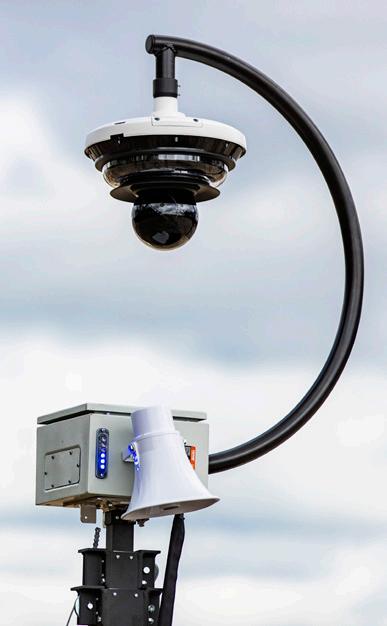
At the core of Sharpvue’s success is its made in the USA manufacturing. Each trailer is designed with durability, scalability, and customization in mind. Dealers and customers can request custom-branded trailers, allowing the units to not only serve as mobile surveillance platforms but also as visible brand extensions in parking lots, construction sites, or special event spaces. With OEM branding wraps, the trailers reflect each company’s identity while sending a clear message: security is a top priority.
This flexibility extends to system integrations. Sharpvue works seamlessly with Alarm.com, Verkada, Genetec, Hanwha Vision, Motorola, Wisenet Wave, and more, ensuring customers don’t have to abandon their preferred video management system (VMS). Instead, the solution meets operators where they are, removing the costly barrier of being forced into a new platform.
Mobile surveillance is only as strong as the power behind it. Sharpvue has engineered a proprietary electrical and solar design that charges the system fully in just three to four hours. Once charged, the unit can operate for four continuous days— even in total darkness.
This efficiency eliminates one of the biggest frustrations with mobile surveillance: downtime. Whether deployed for parking lot security during peak retail seasons, to monitor high-risk sites, or for quick response after natural disasters, Sharpvue ensures operators don’t have to worry about power interruptions.
Connectivity is where Sharpvue truly sets itself apart. While many providers advertise “unlimited” 5G service, fine print often reveals caps, throttling, or costly overage fees. Sharpvue, however, offers truly unthrottled, unlimited 5G service—with optional Starlink satellite integration for remote or rural deployments.
This means no service degradation, no hidden costs, and no worries when bandwidth usage spikes. For loss prevention and asset protection professionals who need reliable, around-the-clock access to video feeds, this level of connectivity ensures sharp, uninterrupted visibility.
Sharpvue doesn’t just capture video—it streams continuously to the cloud, transforming the user experience. Instead of pulling video from the trailer itself, Sharpvue users access footage directly from the data center, much like streaming Netflix or YouTube.
The result? Instantaneous, lightning-fast access to both live and archived video. With most competitors, retrieving recorded clips requires submitting a support ticket or waiting for a third-party response. Sharpvue eliminates that friction: its VMS is entirely self-service. Users can pull up live feeds, scrub archived video, and export clips without waiting on anyone.
Better yet, the system supports an unlimited number of simultaneous users with zero degradation in service. Multiple team members—from local store managers to corporate LP analysts—can view live video at the same time without slowing the system down.
For command center teams, Sharpvue introduces another game-changing feature: the Sharpvue Video Wall. With it, any TV can be transformed into an always-on, virtual monitoring hub displaying live feeds from trailers across the country.
Unlike other mobile surveillance systems, Sharpvue’s data-center-first approach allows users to view multiple trailers on the same VMS screen and search video across one common timeline. Competitors restrict operators to one location at a time, severely limiting oversight. Sharpvue gives retailers a unified, national view—ideal for LP teams monitoring multiple markets or managing temporary deployments during high-risk periods.
Beyond core surveillance, Sharpvue trailers are loaded with features designed for real-world risk mitigation: l 360-degree multisensor cameras with PTZ provide complete site coverage.
l NDAA-compliant cameras ensure compliance with government security standards.
l Smart AI search detects motion and objects, speeding up investigations.
l Onboard strobes and PA talk-down systems allow teams to intervene in real time.
l Live health monitoring provides visibility into GPS location, solar performance, battery life, communication signals, and video system health. Together, these features give operators peace of mind that their trailers are always online, secure, and effective.
Despite its advanced technology, Sharpvue is also more price-competitive than many alternatives. By reducing support overhead, eliminating bandwidth overage fees, and removing the need for specialized technicians to retrieve video,

Sharpvue lowers total cost of ownership while maximizing impact.
For dealers, this creates attractive margins and reliable recurring revenue streams. For customers, it means affordable access to a best-in-class surveillance solution that doesn’t compromise on performance.
The retail and food service industries continue to grapple with organized retail crime, parking lot incidents, and heightened security demands across both urban and remote sites. Traditional solutions—whether static cameras or basic mobile towers—often fall short in flexibility, cost-effectiveness, or ease of use.
Sharpvue fills that gap with a forwardthinking platform that pairs enterprisegrade security with real-world usability. Its combination of rapid deployment, continuous power, truly unlimited connectivity, lightning-fast cloud access, and flexible VMS compatibility gives LP teams the agility they need to respond to today’s threats.
At a glance, here’s why Sharpvue is quickly becoming the go-to solution for asset protection leaders:
l Made in the USA with custom branding options
l Fully charges in three to four hours, with four days of continuous operation
l Unthrottled, unlimited 5G connectivity, with Starlink support
l Cloud-first streaming for instant video access
l Unlimited simultaneous users, with multi-site viewing on one screen
l Self-service VMS—no waiting on third parties for archived clips
l Sharpvue Video Wall turns any TV into a real-time monitoring hub
l Compatible with all major VMS platforms
l Lower cost than competitors, with higher performance
Loss prevention and security leaders are no longer content with systems that throttle their data, limit their visibility, or lock them into proprietary software. They need solutions that are as dynamic as the risks they face. Sharpvue delivers exactly that.
By combining continuous power, true unlimited connectivity, and a datacenter-first approach to video streaming, Sharpvue has created a surveillance solution that is faster, more flexible, and more cost-effective than anything else on the market. For retailers, the message is clear: with Sharpvue, you don’t just monitor risks—you stay ahead of them.
For more information, go to: www. theintegritusgroup.com/retail-solutions/ or reach out to Kevin O’Brien directly at: kobrien@theintegritusgroup.com l

Managing assets across retail operations is challenging enough, but teams today are also dealing with issues from employee fraud along the supply chain to multi-state organized retail crime (ORC) operations and beyond. As ORC groups and opportunistic thieves become increasingly sophisticated, so too must loss prevention solutions and strategies.
To give retailers a much-needed edge, Sensormatic Solutions has added robust new machine learning enhancements to its Shrink Analyzer application.
Even before these updates, the Shrink Analyzer application was a powerful loss prevention solution for investigators. Its industry-leading analytics deliver rich insights into the causes and methods of shrink through item-level loss event data, and it can even speed the evidence collection process to help investigators and law enforcement combat ORC.
Recently, however, Shrink Analyzer took another step forward with the inclusion of new machine learning technology designed to give retailers even more powerful tools to combat shrink. These include a new, cutting-edge Sweetheart Detection capability, a holistic Shrink Confidence Score, and more.
Some forms of employee fraud at the point of sale, like cash theft or discount manipulation, are often easily detectable due to the traces of data they leave behind. Sweethearting, on the other hand, is notoriously difficult to detect for a variety of reasons. Checkout areas are often crowded with people and products, and associates can scan and bag items quickly, making

accurate identification of theft difficult—if not impossible.
“Retailers have never been able to quantify sweethearting as a line-item loss,” said Eric York, global business analyst at Sensormatic Solutions. “It’s always been included as part of a total shrink estimate on the P&L. By definition, it’s the absence of data that has driven the general shrink categorization. Retailers would estimate it, but they could never know the true financial impact sweethearting was having on their bottom lines—until now.”
With the inclusion of Shrink Analyzer’s new Sweetheart Detection capabilities, retailers can eliminate that guesswork and fully understand the impact of employee theft at points of sale.
“Every retailer knows that sweethearting is a growing problem,” said Myron Burke, global leader for solutions management at Sensormatic Solutions. “At the same time, almost every retailer also collects reams of data that, when connected and analyzed
with the right machine learning capabilities, can help them understand the scope of the problem.”
A common sweethearting scenario, in which an item is added to a customer’s order without being scanned, can now be identified and tracked thanks to Shrink Analyzer’s new machine learning capabilities and its ability to aggregate data from multiple sensors and sources in and around the store.
“If a stolen item was tagged appropriately, the retailer can track that Electronic Product Code (EPC) through a specific checkout lane or RFID-based exit system. They can then collate that with point-of-sale inventory data to determine which associate was clocked in and assigned to the register in question,” Burke said. “Using this sensor-fusion approach, Shrink Analyzer’s Sweetheart Detection can not only give that retailer high confidence that this loss event was a sweethearting theft, but it can also deliver insights into who was involved—
and precisely what and how many items were lost.”
The result is what Burke called “the beginning of a true P&L-level understanding of the impact of shrink.”
“It’s no longer an unquantified loss,” he said, “It’s a specific item, a specific dollar amount. Not only can the retailer report on that, but they can also adjust policies and procedures accordingly to minimize it in the future.”
simplifies the data aggregation and cleaning processes. The new, more accurate shrink insights generated as a result can help retailers make decisions faster and with more confidence.
“Retailers and loss prevention teams are extremely busy, and they’re swamped with data from disparate sources,” York said. “The Shrink Confidence Score is designed to be a kind of shepherd that distills all that data and guides them to the most crucial insights.”


Another noteworthy addition to Shrink Analyzer is the arrival of a “Shrink Confidence Score.” Designed to give retailers and loss prevention teams an at-a-glance understanding of the sources, locations, and dollar values of loss events, the machine learning-powered Shrink Confidence Score
York also stressed that loss prevention professionals are trained to understand the nuances that determine whether an action is theft—or merely exceptions that look like theft.
“There’s an art to loss prevention that machine learning can’t replicate,” he said. “But what it can do is help loss prevention professionals practice that art more efficiently and effectively. With it, loss prevention teams no longer have to sift through mountains of likely exceptions and can instead focus on high-impact loss events.”
While Shrink Analyzer’s machine learningpowered features have only been piloted for a short while, some results are already becoming clear.
“Shrink Analyzer enabled a retail partner of ours to discover that a repeat offender had been targeting multiple stores, often stealing thousands of dollars of merchandise in a single event,” Burke said. “This wasn’t a new actor, either. This person had been targeting their stores for quite some time, but like
many experienced thieves, he had been able to remain totally unknown to them. But by using Shrink Analyzer’s full feature set and data from a variety of sensors, the retailer was able not only to determine that this individual was continually stealing from them, but to identify the individual in question and gather evidence from video and other retail enterprise sources.”
The retailer, York said, then turned that evidence over to law enforcement and prosecutors, who were able to build a case in a matter of weeks.
“Retailers know that these skilled thieves are targeting them. What they don’t know is who these thieves are, how they operate, and when and where they tend to strike,” he said. “But Shrink Analyzer enables retailers to finally understand all those things and help law enforcement and prosecutors build an effective case against them—and that’s truly a game changer.”
Both Burke and York said that early successes like these are exactly the kind of outcomes they had in mind when building Shrink Analyzer’s latest features.
“Now that these tools are in retailers’ hands, we’re hearing about more and more stories like these every day,” York said. “A lot of retailers have really been surprised by how easy to use and effective these tools have been.”
“In some cases,” Burke added, “they’ve even surprised us.”
The Shrink Analyzer application’s cloudbased platform aggregates and analyzes data from a variety of sources, turning it into insights that help loss prevention teams protect profits, ensure shopper and associate safety, and improve customer experiences. The inventory platform agnostic application works seamlessly with Sensormatic Solutions’ RFID hardware and can work alongside any retail analytics ecosystem.
With its new machine learning capabilities, Shrink Analyzer now gives retailers even greater insight into previously hard-to-quantify loss events, like sweethearting. Plus, its new Shrink Confidence Score helps loss prevention teams focus on and take action to prevent the most impactful sources of shrink. To learn more about Shrink Analyzer, visit www.sensormatic.com/loss-preventionliability/shrink-visibility/shrink-analyzer. l

The Loss Prevention Foundation (LPF) is a leader in educating and certifying retail loss prevention and asset protection professionals by providing relevant, convenient, and challenging educational resources. The LPF is dedicated to elevating the industry through its accredited LPQualified and LPCertified courses. For more information, visit losspreventionfoundation.org.

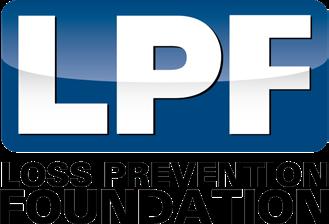





“Obtaining my LPQ has been an incredible achievement in both my academic and professional journey. The program provided me with a thorough understanding of the fundamentals of loss prevention, while also giving me the confidence to step into the field with an established foundation. As a student, the LPQ has not only expanded my knowledge but has also set me apart by showing my dedication to pursuing a career in this field. I am proud to be LPQ certified and would encourage anyone interested in loss prevention to take this valuable step forward.”

Recent LPC Recipients
Josiah Lindquist, LPC, IKEA
Mike Daly, LPC, Northeast Shared Services
Shawn Carter, LPC, Tractor Supply Company
Michelle Murrell, LPC, Family Dollar
Dennis Michael Mayo, LPC
Joseph Kyle Mayton, LPC, Bargain Barn
Destiny Riehl, LPC, AAFES
Rob Faulise, LPC, Harbor Freight Tools
Bob Wright, LPC, LPQ, Kwik Trip
Recent LPQ Recipients
Donald Keith Russell, LPQ, TJX
Michael Nero, LPQ, TJX
“This journey through LPQ has been both challenging and rewarding as it pushed me to grow in my skills, knowledge, and confidence. I would strongly recommend this certification to those who are passionate about their loss prevention careers!”
Kelly Williamson, LPQ, Whole Foods
Adora Belcher, LPQ, Retail Industry Leaders Association (RILA)
Robyn Alexander Gundlach, LPQ, Meijer
Sean Segasture, LPQ, The Home Depot
Enid Rohena, LPQ, Dave and Buster’s
Priscilla Gomez, LPQ, Navy Exchange Service Command (NEXCOM)
Elizabeth Cross, LPQ, TJX
Angelo Harris-Zeballos, LPQ, TJX
Christian Arellano, LPQ, The Home Depot
Danish Khan, LPQ, Amazon
Mariah E. Nunez, LPQ, ULTA
Sean Maddox, LPQ
Kendre Washington, LPQ, TJX
Elizabeth Houk, LPQ, TJX
Ashley Frost, LPQ, TJX
Stefani Paige Zebalese, LPQ, University of Buffalo
Managing inventory is becoming increasingly complex for today’s retailers. Retailers are seeing an everincreasing amount of products returned to stores, surging close to $900 billion in 2024. Even before COVID-19, customers utilized curbside pickup, BOPIS, and ship-fromstore to purchase products, but that has only accelerated since the pandemic. And today’s customers have higher expectations than ever before, assuming that inventory will consistently be on-shelf and available for a seamless retail experience.
All of this puts a great deal of pressure on retailers, who need highly accurate inventory counts to ensure real-time visibility into inventory levels. And while using third parties for inventory counts may have worked in the past, the current environment is too complex for outside teams that are unfamiliar with a store’s inventory and lack the same level of engagement as a store’s associates.
Switching to a self-scan inventory counting model can make the difference between a lackluster customer experience and an excellent one. Why? By utilizing a solution where inventory counts are conducted by your store associates, you ensure that inventory data is highly accurate and that inventory levels are visible in real time. With Zebra’s Workcloud Inventory Visibility, retailers can achieve up to 98% inventory accuracy. This keeps shelves stocked and provides more accurate data for replenishment, ensuring key products are always available.
With customers today expecting a seamless in-store experience, out-of-stock issues can drive customers into the arms of competitors. Better inventory accuracy keeps shelves stocked and customers quickly moving through your stores.
These solutions also help with preventing theft and loss across retail stores. By providing accurate data on stock levels,
loss prevention specialists can identify discrepancies, initiate or follow up on investigations, and understand the issues that arise so they can be avoided in the future. For example, if discrepancies in gift card inventory are uncovered as a result of an inventory count, loss prevention teams can launch investigations and monitor specific gift card SKUs to see where and when theft is occurring, making it easier to catch those stealing from your stores. This all comes from having your store associates leverage self-scan inventory counting solutions, which produce more accurate and actionable data.

Leveraging cycle counts, where inventory counts are conducted on specific items or sections of the store, can also provide significant loss prevention benefits. If an investigation is resolved and ongoing theft has been stopped, cycle counts can be used to periodically check certain items to make sure theft isn’t occurring again.
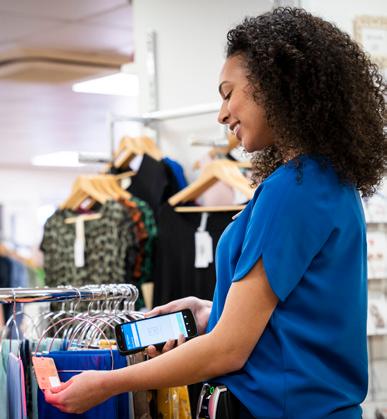
All of this minimizes shrink and makes it significantly easier to conduct investigations into loss and theft, ultimately making a positive impact on your bottom line.
When you utilize your own store associates for self-scan inventory counts, you can schedule inventory events according to your preferred schedule and your team’s timelines. It’s significantly easier to make schedule changes when necessary, eliminating the hassle and complexity that comes with trying to reorganize the labor of a third-party service. This also makes your store associates feel like they have a bigger stake in the day-today operations of the store. Instead of feeling disconnected, they work as a team on a larger project and can feel their contribution to a greater whole.
Workcloud Inventory Visibility, Zebra’s self-scan inventory counting solution, helps unlock cost savings of up to 50% by enabling you to perform your own physical inventory counts. With Workcloud Inventory Visibility, you’ll have the right tools for inventory counting, making it easy to optimize your planning, execution speed, and count accuracy. Learn more at zebra.com/us/en/ software/workcloud-solutions.html. l








































































This New Product Spotlight section provides readers with information on new products and services from leading retail asset protection solution providers. If your company is looking for new technology or solutions, please check with these vendors as well as the other advertisers throughout the magazine. Visit LossPreventionMedia.com for more information about these new offerings.

Protect profits while giving each customer the experience they deserve. Engage provides real-time protection with AI-driven, behavior-based recommendations to streamline returns, claims, and appeasements. Unlike other solutions, Engage uses data from all channels to ensure accurate return and claim decisions—preventing fraud and abuse wherever consumers shop.



The AXIS D4200-VE is a multi-purpose network strobe speaker that provides both visual and audio alerts. This durable, outdoor-ready device offers customizable strobe lights with multiple colors and supports live or prerecorded audio for warnings, announcements, and background music. It includes built-in two-way audio and analytics to detect sounds. It can be powered via PoE and can also provide power to a network camera to provide proactive surveillance for stores.

Axon Outpost brings cutting-edge ALPR and livestreaming to any location. Designed for rapid deployment and rugged performance, it captures license plates and vehicle details in real time—powered by solar or AC. Integrated with Axon Fusus, it delivers unmatched vehicle intelligence for retail, healthcare, education, and public safety environments.



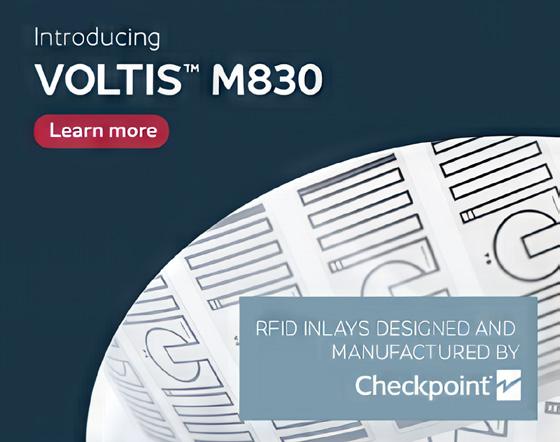
Checkpoint Systems introduces Voltis™ M830—our smallest inlay designed for general merchandise. Combining a compact footprint with high read reliability, Voltis delivers unmatched performance from factory to sales floor. ARC-certified and retailer-ready, Voltis accelerates vendor onboarding, reduces shrink, and ensures fast, accurate visibility across dense assortments.


Now featuring the smaller Smart Release Lock from our popular Gen6, the Gen5 SR delivers secure protection with easy one-button release. You can hide the base, adjust cable length, and keep displays clean while preventing theft. Smaller, smarter, stronger—the new Gen5 SR.
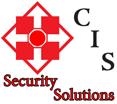
You’re spending millions to protect your people and property—but are those guards in the right places? CAP Index’s Guarding Optimization Evaluation delivers hard data and expert analysis to uncover over-guarded sites, underprotected risks, and wasted spend.
No fluff. Just a smarter, proven strategy to maximize protection and ROI.
Ready to get more from your investment? Scan the QR code to see how it works—and where to start.

We listened to our customers and enhanced our SAM2CAM AM-EAS system. The result: a more discreet camera design. The seamlessly integrated Hanwha camera captures crisp, eye-level footage to accelerate investigations and strengthen case resolution. With computer vision, RFID, smart sensors, and LiDAR, SAM2CAM delivers next-generation protection that evolves with you.








SmartConnect™ is Gatekeeper Systems’ managed service that transforms loss prevention systems into proactive, connected assets. Tailored for Purchek® and CartControl® technologies, it delivers enterprise oversight, remote monitoring, swift issue resolution, and automated optimization— maximizing ROI, reducing onsite costs, and freeing your teams to focus on customers while ensuring safer, smarter operations.


Protecting large properties has never been harder—or more expensive. Guards can’t be everywhere at once, and cameras miss blind spots. That changes now with Flock Aerodome Drone as Automated Security (DAS): a fully automated, dronein-a-box solution that launches the moment an alarm triggers.


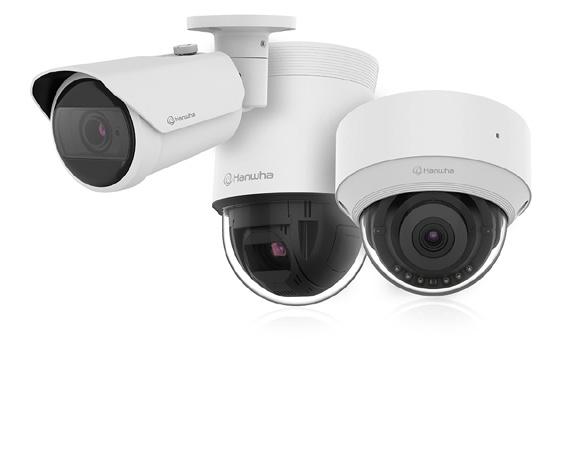
Hanwha Vision cameras help retailers strengthen loss prevention, monitor traffic flow, and enhance the shopping experience. Multiple series offer multiple capabilities. Many models use sophisticated AI technology to reduce false alerts and decrease storage requirements. Cameras are available in different form factors, with intelligent video analytics; WiseStream III + H.265 compression technology; 120 dB True WDR; and NDAA, TAA, and FCC compliance. Choose the right camera for your operations.

i3 Smart-ER is an integrated exception-reporting platform that detects suspicious transactions, ranks risk, and links each event to video for rapid review. Built by retail experts and powered by AI, it flags theft, fraud, and organized retail crime, turning POS data into actionable cases that deter loss and drive recoveries.








InstaKey invites you to enhance your access control with the all-new PDQ Spirit Series! Whether you prefer RFID, PIN code, mobile access, or key override, we’ve got the perfect solution for you. Available in lever sets, deadbolts, mortise locks, and exit trims. Contact us to learn more.



Did you know that InstaKey and PDQ Manufacturing have small format interchangeable cores (SFIC) in stock and ready to ship? With less than a five-day lead time on master keying services, securing your facilities has never been easier—or faster. Experience the InstaKey and PDQ difference in quality and speed!




InstaKey Security Systems is excited to introduce its next innovative breakthrough: the VAULT Key Control System. Patent-protected door technology through 2044. Precision-engineered to be backward compatible with existing Standard (A–M) keyway or InstaKey (E–K) restricted keyway systems. BHMA certified with a five-year warranty, it reduces downtime and lowers costly system-wide replacements.


InstaKey’s latest version of its flagship key management software, SecurityRecords® is out! This new release marks a milestone in the evolution of our SaaS platform, bringing unprecedented features, enhancements, and improvements such as enhanced user interface, advanced analytics and reporting, improved performance, security upgrades, and more!


The iD POS Pro is an RFID reader at the point of sale. It speeds up checkouts, updates inventory levels in real-time, and also supports many loss prevention use cases. The RFID POS reader enables RFID-based EAS and helps with exception reporting, detecting internal theft, return fraud, and proof of ORC. With end-to-end traceability and chain-of-custody proof, it turns your POS into a powerful loss prevention asset.
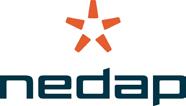


An alarming upgrade to our popular Concealed Pin Tag has arrived! The new Alarming Concealed Pin Tag adds even more security to our exceptionally effective solution. Retailers who have already realized the cost savings of the one-piece design can now benefit from additional deterrence as well. We also offer custom color options and branding.




LVT’s introduction of Agentic AI in the recent product launch is revolutionizing physical security. Agentic AI now allows LVT units to detect and deter bad actors with automated callouts based on characteristics such as clothing color and even items the person is carrying, allowing for increased human efficiency and protection.



The R1 is the latest retail body camera from Reveal, purposefully designed to boost wearer safety. Compact yet powerful, the R1 offers a full-shift battery and pre-record buffer to capture footage before recording activation. A customizable front display supports overt recording messages or retailer branding.



Flexible, Enterprise-Grade Surveillance Solution Built in the USA
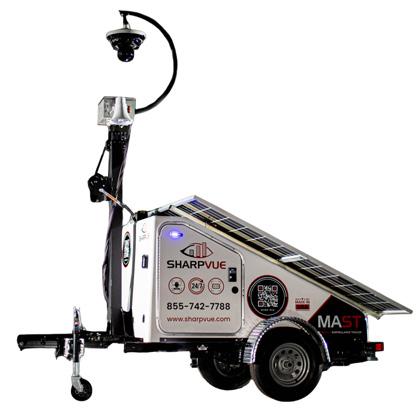
The Integritus Group delivers Sharpvue Mobile Surveillance Trailers—made in the USA with four-day continuous power, true unlimited 5G/Starlink connectivity, and instant cloud video access. Customizable, VMS-compatible, and cost-effective, Sharpvue provides enterprise-grade protection for parking lots, remote sites, and more. Trusted by asset protection leaders to stay ahead of threats.



Risk Pulse is the only site-specific risk assessment to integrate six key categories in a single, easy-to-understand report. Using advanced and proprietary analysis, Risk Pulse provides intricate insights into crime, natural disasters, wildfires, power outages, economic threats, and industrial hazards risks to help you protect your people, places, and assets.



Unlock the full potential of ThinkLP’s platform for comprehensive investigations, including organized retail crime (ORC). Get a complete picture of your investigation by tying together suspects, vehicles, boosters, fences, and other related items across maps and timelines. Accelerate case resolution and enhance your asset protection strategy.


Designed with ADA compliance and keyless egress in mind. Single, double, or bi-parting sliding glass doors, these unique powder coated tubular steel Xpanda security gates secure the easiest point of entry when you need it and neatly retract when you don’t.


Conducting effective interviews isn’t one-size-fits-all, and neither is training. At Wicklander-Zulawski (WZ), we offer courses for every stage of your career. Whether you’re just starting out, sharpening advanced skills, or refreshing yourself on the latest strategies. Grounded in evidencebased methods, our programs give you the tools to build rapport, create a positive interview environment, and secure actionable information. From immersive workshops to flexible self-guided practice, WZ equips you to conduct interviews that uncover the truth. Pick your shade of success with training designed to be the perfect match.
Level I Investigative Interviewing Techniques
Attend our iconic course in-person or virtually. Now available in Spanish too!
Level I I
Practical Application Worshop
Go deeper with immersive skill-building and investigating cases from initial complaint to full conclusion.
THE Link Evolved
A dynamic simulation to practice and conduct a full WZ Method style interview in a risk-free environment.
Focused LIVE Webinars
Zero in on the specific skills you need, from organized retail crime to remote interviewing and everything in between.
AI Webinar Experience
Learn it. Try it. Master it. With live instruction and an AI interviewing tool that redefines how you prepare for interviews.
Explore techniques that reveal what memory hides, avoid missteps, and unlock more productive conversations.
WZ Academy 10-Hour Online
Experience an introductory level of the WZ Method with this interactive, self-paced course built to help you succeed.






The WZ 2026 training schedule is coming soon! Scan now to get an exclusive early release sent straight to your inbox once it’s available.





























































Don’t miss any of our award-winning magazines. Subscriptions are free to retail professionals, law enforcement, and solution providers serving the loss prevention industry in the US and Canada. Have each issue of the magazine sent to your home or office by simply going to LPMsubscription.com or scan the QR code.
Provide a list or handout magazines to your office or store associates. Bulk quantities of the magazine can be requested by emailing circulation@LossPreventionMedia.com. We will contact you to work out the best method to fit your organization.

Our digital channel offers original articles written by LP Magazine staff, thought-leadership contributions from industry experts, breaking news, podcasts, and much more. Stay in-the-know by adding your email address to our digital channel database. Go to LossPreventionMedia.com/email or scan the QR code.
For help with any subscription issue, including address changes, email changes, or cancellations, contact circulation@LossPreventionMedia.com.


Publication title: Loss Prevention. Filing date: 10/1/25. Issue frequency: bi-monthly. No. of issues annually: 5. Mailing address of office of publication: 33 Walt Whitman Rd, Suite 121W, Huntington Station, NY 11746. Mailing address of headquarters: same. Name and address of publisher, editor, and managing editor: Caroline Kochman, Publisher; Stefanie Hoover, Editor; Courtney Wolfe, Managing Editor, same address as above. Owner: Loss Prevention Foundation, same address as above. Publication title: Loss Prevention Magazine, aka LP Magazine, Issue date of circulation data below: Summer 2025.
Name and title of publisher: Caroline Kochman, President Date: 10/1/2025

Jacque Brittain, LPC Editorial Director
Brittain is the editorial director for LP Magazine. Prior to joining the magazine, he was director of learning design and certification for Learn It Solutions, where he helped coordinate and write the online coursework for the Loss Prevention Foundation’s LPC and LPQ certifications. Earlier in his career, Brittain was vice president of operations for one of the largest executive recruiting firms in the LP industry. He can be reached at JacB@LossPreventionMedia.com.

Aterrific article in this edition of LP Magazine focuses on the power and importance of mentorship. We discuss how leaders who have had strong mentors tend to have a more balanced skill set, thinking beyond tasks and embracing the bigger picture. We discuss how mentorship enables us to become more strategic leaders, facilitating growth and evolution at every stage of our careers. We hear great stories on the value that mentorship has had on some of the industry’s most prominent leaders, how it has impacted their careers, and sound advice on how to become a more powerful and effective mentor to our teams and those we serve. These are great lessons and important reminders of mentorship in shaping careers and developing future leaders.

Mentors come in all shapes and sizes. And as the article emphasizes, the most critical lessons we learn as leaders don’t come from a handbook; they come from real conversations.
Mentors come in all shapes and sizes. And as the article emphasizes, the most critical lessons we learn as leaders don’t come from a handbook; they come from real conversations. Both sides of the interaction will focus on listening, supporting, and challenging perspectives. But there is also a quiet side of mentorship based on the everyday interactions that we have with all those around us—the less formal conversations and observations that help shape our personal and professional character.
Informal mentoring relationships develop naturally and tend to continue growing over a long period of time. The nature of the relationship typically sets the groundwork for the degree of trust, commitment, teaching, and learning that is established. Depending on the topic, situation, or nature of the association, we can often find ourselves on either side of the interaction, which only further emphasizes the value of these relationships. Although they may be more informal, they can still challenge us with high expectations, testing our perspectives while offering persistent encouragement that helps build knowledge, insight, and self-confidence. Almost any relationship can lead to some form of informal mentoring, and most of us can point to those that fit this role for us. But that doesn’t make this form of mentoring any less important, as these bonds have
lasting effects on our lives as well as the style and approach we establish for our careers. Whether this form of mentoring occurs when you reach out for guidance or when someone reaches out to you to benefit from your advice and experience, both individuals involved will grow personally and professionally in the process. Either way, these relationships can be very effective and extremely rewarding for both parties and often result in long-lasting friendships.
It’s just as important to recognize the value of the dark side of mentoring—a detractor or anti-mentoring, if you will—relationships that can have a powerful, but indirect influence on our personal and professional character in other ways. These individuals provide examples of how not to react, respond, or behave, and have a significant impact on the way we lead. They are important to our growth and development, but for very different reasons.
We can all point to examples of individuals who fit this mold as well—those who have speckled our careers with poor impressions and reminded us of behaviors that we would never want to emulate as we grow and develop as leaders. Some examples can be blatantly obvious, while others litter our minds with comments or behaviors that are much more subtle, but each point to important character-building lessons that shape our style and approach to leadership.
What’s most important is to pay attention. Always look for those who can help make you better at what you do. Show patience, keep an open mind, and look for the value in every relationship. Professional growth is a process that never stops, no matter how long we’ve been around or what level of success we achieve. We shape our futures by learning lessons from all those we interact with, whether that involves our leaders, peers, subordinates, or anyone else given the opportunity to share their influence, both good and bad. Remember, it’s not just what they give us, but what we walk away with that will make the most difference. l


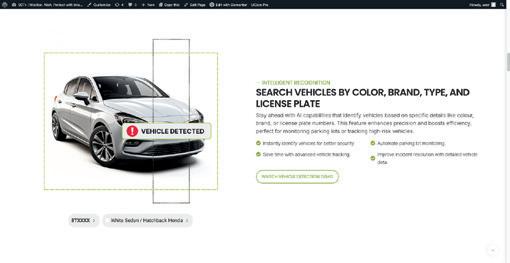








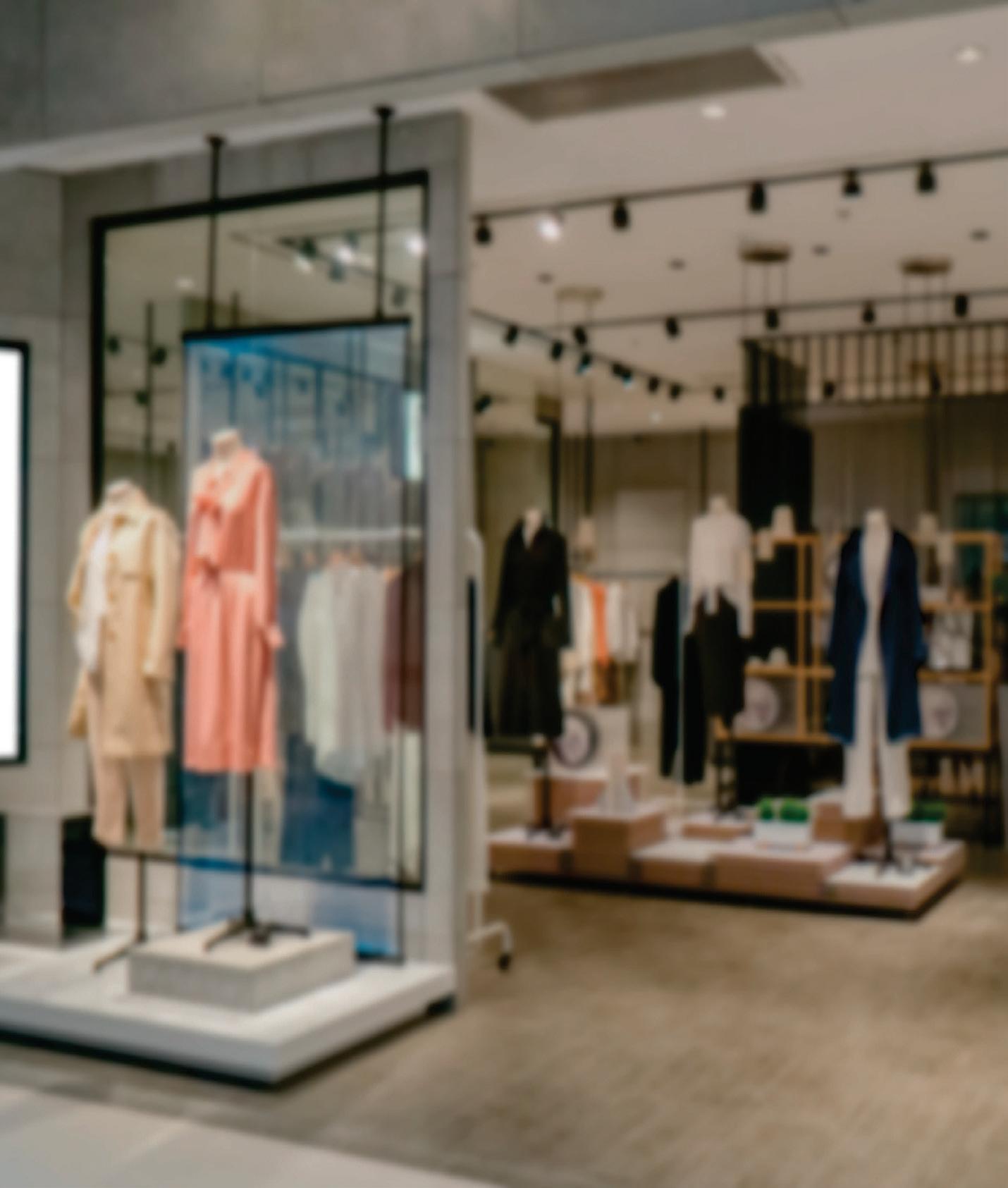
CONTROLTEK’S newly redesigned SAM2CAM AM-EAS system now features an in-line camera delivering a clean, low-profile design that blends seamlessly into your retail environment.
Positioned at eye level, the integrated Hanwha camera captures crisp, face-level footage to speed up investigations and strengthen case resolution while seamlessly integrating computer vision, RFID, smart sensors, and LiDAR for next-generation protection.
All the power of our proven system — now in a sleeker form.

Scan the QR code to see SAM2CAM in action.
